




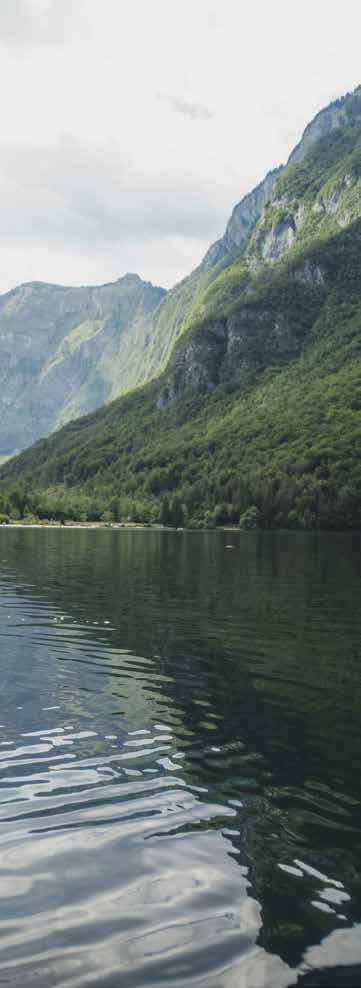
The Alps, the Mediterranean, the Karst and the Pannonian Plain are exceptional locations for exercising outdoors in nature. All these regions can be experienced in Slovenia, the world’s first green destination, and the only country in Europe that combines such diversity. You can walk or cycle Slovenia from one end to another or stop and exercise in your own way in this exquisite green corner of the world.
The land is perfect for hiking amidst the incredibly diverse landscapes. It surprises with vistas across hills and valleys, ascents to Alpine peaks rising more than two thousand metres high and descents into Karst caves that lie more than 1,500 metres below sea level. Its image is green. You are visiting one of the most forested countries in Europe.
Water demonstrates its wealth of features here. The sea, lakes, rivers and streams make your wish for different forms of recreation. Adrenaline experiences and relaxation come true. Droplets sprayed from waterfalls refresh passers-by and drinking waters quench the thirst of the weary traveller. Mineral and thermal waters replenish strength for moving and exercising.
The air changes the appearance of this green country. In every season, it brings a different character to the views from the heights. Air masses and currents thrill those who sail among the clouds, birds or treetops.
Passion for movement takes us outdoor 365 days of the year. On 23 September, a state holiday dedicated to sports and recreation is celebrated in Slovenia. In green, active and healthy Slovenia, this Day of Slovenian Sport is also dedicated to the incredible achievements of Slovenian athletes who have been inspiring us for decades. We follow their lead with our own sports and recreational victories and challenges. Choose your activities for health and wellbeing.
Let's cycle around the country of the best cyclists in the world! Let Primož Roglič, the winner of an Olympic gold medal, and Tadej Pogačar, the two-time winner of the Tour de France and an Olympic medallist, be our role models.
Let's discover the waters that Olympic gold medal winning canoeist Benjamin Savšek knows to the last drop, and Alenka Artnik, the world record holder in freediving. Let's ski and snowboard in mountain resorts where Žan Košir, a snowboarder with three crystal globes and four Olympic medals, trained. Let's run on skis in the venues where Jakov Fak, a silver Olympic medal winning biathlete, competed.
Let's conquer mountain peaks and steep walls that Olympic sport climbing champion Janja Garnbret also knows about. Let's find peace in ourselves, like judoka Tina Trstenjak, the winner of two Olympic medals, finds it again and again. Let's take care of our physical and mental fitness in Slovenia, the land of famous handball, volleyball and basketball players, such as the NBA star Luka Dončić.
We follow the top athletes of Slovenia by choosing recreation that helps us maintain a healthy lifestyle. Let's take part in sport and recreational trials that satisfy our desires for our own achievements.
Find your recreational challenge at: www.slovenia.info/events
We know how to support our sport heroes at matches around the world, and everyone can witness the passion of Slovenian fans at major international competitions hosted in Slovenia. See you at the great sport venues!
Find the events where you can show your true fandom at: www.sloveniainfo/cheer


In Slovenia you have it all at hand. School is within walking distance, but just far enough for a kid that the way there can drag a bit. It seems to me that in Slovenia we all quickly master the bike, and then instead of just having it as a means of transport, we start to use it for the most beautiful type of exercise. The bike is great to get around faster when running daily errands, but when you're in need of a challenge, cycling trails are the choice that takes you to the most beautiful destinations.
PRIMOŽ ROGLIČ, cyclist, Olympic champion and three-time La Vuelta winner


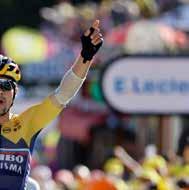

When I was a child, Ljubljana, the city of my childhood, had enough playgrounds and basketball hoops. Of course, I spent most of my time on the playground near my home. Once the passion strikes you, you see the hoops everywhere! But certainly in Slovenia, which is a heavily forested country, it is absolutely delightful to run along a forest path and to switch off surrounded by nature.
LUKA DONČIĆ , basketball player, NBA star

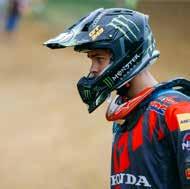


As a schoolkid, I loved football. When I got a bit older, our local cyclists took me with them for dry winter training and that's where it all began. The cycling races mainly take place in the summer, but I am also excited for winter, when I have the chance to try something new to stay in shape. Especially if it's outdoors, in nature.
TADEJ
POGAČAR,cyclist, two-time Tour de France winner and Olympic medallist



FIND PEACE WITHIN

Sometimes outdoor exercise gives me the energy to complete what I've started and other times it calms me down, so I'm not rushing around when I don't have to. I am lucky that my sport takes place outdoors. Perhaps the most important thing is to realise how important it is to spend time in nature, to spend time exercising. And admiring nature. Nature, especially Slovenia's clean, pristine environment always gives us what we need to rejuvenate or calm down.
ILKA ŠTUHEC, Alpine skier, two-time world champion in downhill
Strength, knowledge and skill are one part of my story. The other, and probably more important part is finding peace within yourself to succeed on the tatami. When it gets overwhelming, you have to retreat a little. That's the time to go outdoors and find peace in nature. It helps you find the peace within.
TINA TRSTENJAK, judoka, Olympic and world champion




ŽAN KOŠIR , snowboarder, three-time Olympic medallist PUSH THROUGH
Life is full of ups and downs. In sports, the downs sometimes come with injuries. But just when others are starting to doubt whether you can get back on the racetrack, you prove to yourself that anything is possible if you have the perseverance! With outdoor exercise, discipline and routine anyone can get back on their feet and get off to another great start in life. Try it! In nature, it comes easy.


LISTEN TO NATURE
As a kid, the bow and arrow were my absolute favourite. I set my target on the meadow and enjoyed the almost silent flight of the arrow to the centre of the target. No matter how loud the birds chirped, I was listening for the arrow. Now I mainly train indoors and with earmuffs, but this makes me more conscious of the sounds of nature.
FRANČEK GORAZD TIRŠEK , para archer, four-time Paralympic medallist
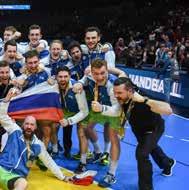


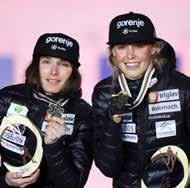

In Slovenia, you'll find water at every turn! A stream, a river, a lake, the sea – everything's at hand! When you wander around, you're drawn to the waters. Some of them are still, reflecting your image. But I have always had a liking for whitewater. You can't just jump into them, because they are often really powerful, but if you start to get to know them slowly, sooner or later you will master them. And get completely soaked through!
BENJAMIN SAVŠEK, canoeist, Olympic and world champion
In addition to good fitness, results and victories, an important motivation for everyone, not just for athletes, has to be well being! Well being is easiest to achieve when we dedicate our time to something we love. Personally, I think I'm lucky: I do what makes me happy. I am sure that every amateur sportsperson can find such happiness for themselves.
JAKOV FAK,biathlete, world champion and Olympic medallist
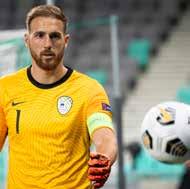
When picking outdoor activities, a country with four distinct seasons is always the right choice. Your favourite form of exercise might sometimes be linked with high mountains, at other times with the seaside, or perhaps with river valleys, or vine-growing hills. You can find excellent centres for outdoor exercise throughout Slovenia. Because everything is so close, you can experience the country’s diversity with your first visit and the many faces of nature during your subsequent visits to this green land. Time and again.
While skiers, boarders and other winter recreational enthusiasts enjoy activities on the snow at one end of Slovenia, it’s possible to hike or cycle on sunny days at the other end of the country, or catch the bora wind on the Adriatic coast.
When the hills turn green, easily accessible mountain huts become busy with hikers and so do the take-off terrains for sky-flying acrobats. An increasing number of climbers are also taking on rock faces near the sea.
Once the sun warms up even the highest Slovenian peaks, there’s no limit to spending time outdoors. In addition to their refreshing environment, the sea, lakes and rivers provide an array of sporting challenges, while green forests shelter many tranquil paths.

When the weather of summer, spring and winter intertwines, those who enjoy sports in any weather and in any season can find their satisfaction. Only one season can be found underground, while the land and the air offer different kinds of excitement.

SO DIFFERENT. SO ACCESSIBLE.
Everything is close in the only European country combining the Alps, the Mediterranean, the Karst, and the Pannonian Plain. It is only about a two-hour drive from the capital and Central Slovenia to even the most remote corners of Slovenia. This means that you can experience four different worlds in a single day. But even a brief encounter with each of them fuels the desire to spend more time discovering its special features and to return to Slovenia.
Find your favourite starting point for all kinds of outdoor sports among the highest peaks and the wildest white waters. Ski, hike, cycle, climb and seek your challenges. Visit the venues of great sporting events, too.
Many wonders of the world can be seen when travelling from the salt pans of the Adriatic Sea to the Karst caves in this country where the mild Mediterranean climate reaches far inland. Explore the opportunities for water sports, climbing, speleology, horse riding and other experiences.
Go on a hike or cycle to the UNESCO heritage sites where towns and the green countryside meet. Run a marathon, discover primeval forests, marshes and mountain pastures. A SUP tour? Fishing in the city? Why not?
Easy hiking and flatter cycling trails lead among the healing thermal and mineral waters, vine-growing hills and castles to numerous sights of interest. Choose your centre for exercising and discover numerous other forms of recreation.

The most local, genuine, experiential, boutique and also sustainability-oriented Slovenian tourist experiences are designated by the Slovenia Unique Experience label. These five-star experiences are evaluated and recommended by the Slovenian Tourist Board. Many of them feature outdoor activities. Make your choice and discover what cannot be experienced anywhere else.
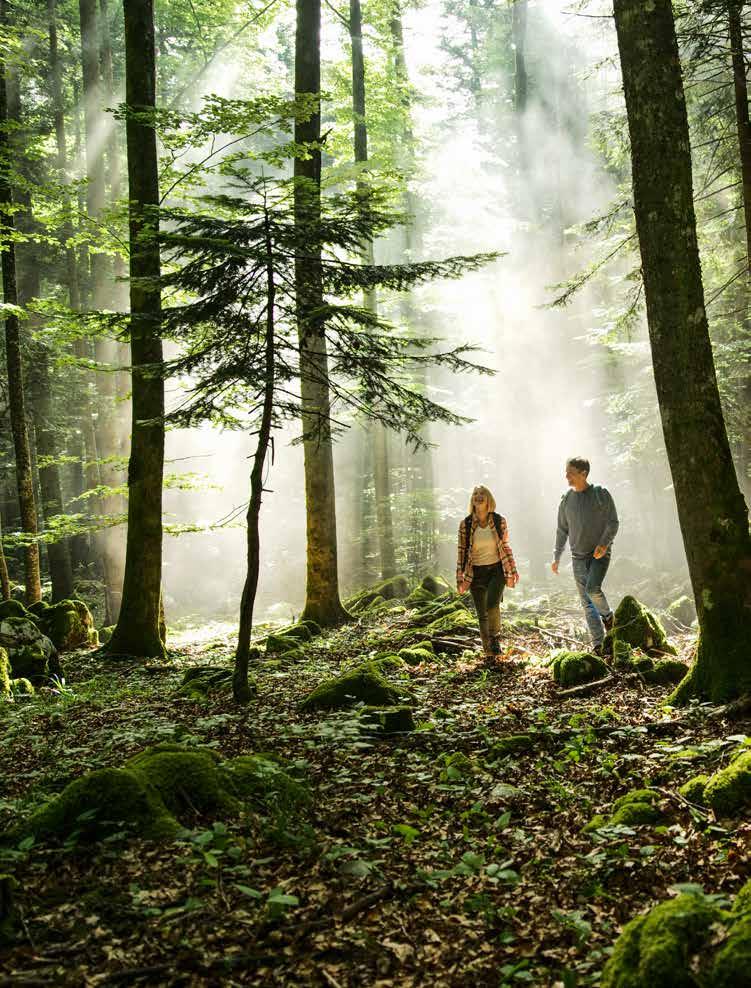
Green, active and healthy Slovenia is known globally for its efforts dedicated to sustainable tourism development. Under the auspices of the internationally recognised Green Scheme of Slovenian Tourism, we are realising green policies and creating green adventures. Why? Because we wish to preserve the incredible diversity of this corner of the world, both for ourselves and the coming generations, and we also want to generously share it with visitors from all over the world.
As much as 60 per cent of Slovenia’s territory is covered by forests and globally important primeval forest reserves can be found only 60 kilometres from the capital. More than one third of the country has been incorporated in the EU network of protected areas, Natura 2000. A fifth of the Slovenian coast is a protected area. With more than 22,000 animal and plant species, Slovenia is one of the most biodiversityrich countries in Europe. It is possible to be in the midst of extraordinary nature anywhere in Slovenia. Always show respect for nature when enjoying your selected forms of exercise.
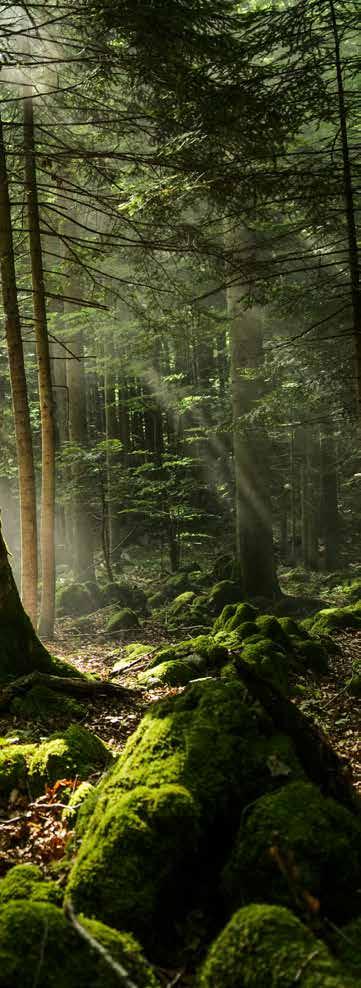
Choose from among more than 100 destinations, accommodation providers, natural parks, tourist agencies and tourist attractions that boast the Slovenia Green label and abide by the internationally established sustainable green strategy.
When in the habitats of rare animal and plant species, respect the rules of individual areas of protected nature. Let's move along marked paths. Let’s not disturb animals with our motor vehicles! Take your litter away with you and dispose of it responsibly.
Choose an environmentally friendly means of transport to reach your selected centres for outdoor activities. Check out public transport connections.
Set off for a journey outdoors properly prepared and equipped. Take water in a reusable bottle with you. Whenever possible, do not use plastic! Slovenian tourism follows the principle of Less plastic for more sustainability!
When wandering around Slovenia, it’s easy to find delicious and healthy food to replenish your energy. Slovenia is the European Region of Gastronomy 2021. You can experience the superb cuisine created by distinguished chefs in many places, but everywhere you wander you’ll find typical local dishes. Enjoy tasty meals at Slovenian inns, tourist farms or mountain huts.
Slovenia was one of the first countries in the world to obtain the Safe Travels label of the World Travel and Tourism Council. Tourist providers respect the responsible GREEN & SAFE travel standards. Please respect them, too. Comply with the recommendations and travel safely and healthily.
More information at ௴ www.slovenia.info/standards

If we want a genuine connection with the land, we seek its diversity on our own. Hike, climb mountains, rockfaces and vantage peaks. Venture into valleys, on hills and plains. Cycle along the trails criss-crossing this incredibly green country. Or jump on a horse. Explore its hidden depths and conquer its vantage heights. Discover it in all seasons. It will surprise you time and again with its diversity. It will encourage you time and again to try out another type of activity. They are all possible in Slovenia.


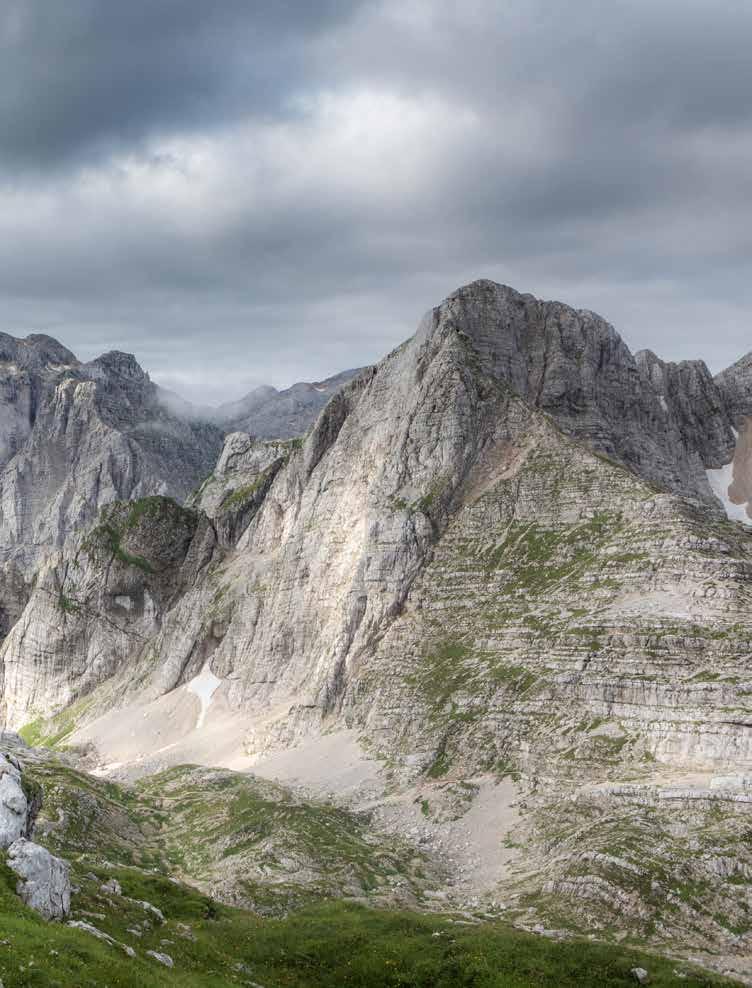
Hiking on trails along plains and over easily accessible hills, low mountains with peaks reaching up to 1,500 metres and high mountains, of which 352 exceed 2,000 metres.
More than 10,000 km of marked hiking trails are maintained by the Alpine Association of Slovenia, one of the largest sports organisations in Slovenia with more than 60,000 members.
5,000 km of marked themed hiking trails
178 mountain huts, shelters and bivouacs
More than 50 certified accommodation facilities for hikers
113 rock climbing sites and several climbing centres in towns
Challenging protected climbing routes – ferratas
Find more information on the website. Set up your active holiday programme. Choose your accommodation and experience more. www.slovenia.info/hiking

Hikers can discover Slovenia all year round. In winter, when trails are frequently hidden under a layer of snow, and when pushing through the fog in autumn, we venture on hikes along the plains and to more accessible spots in low mountains. When the snow melts and nature begins to bud in spring, low mountains with forests, pastures and vantage points become very attractive. At that time, the snow cover is still very deep in the mountains. The majority of mountain huts situated at higher elevations don’t open their doors before June. Summer is the perfect time for conquering the highest peaks. When going into the mountains, observe the weather conditions. Days are hot, but nights are cold and afternoon storms are frequent. So, start your hike early in the morning and carry suitable equipment. You’ll be safest if accompanied by experienced guides.
• Choose trails and goals that suit your physical and mental fitness.
• Check the weather conditions before going into the high mountains and pay close attention to them when planning your route.
• Plan your route with the help of printed guidebooks and maps. Use programmes uploaded to your smartphone (mobile applications) only as support.
• Always make sure that someone knows which route you’ve taken. Enter your name in the registers at mountain huts. Check whether mountain huts are open and book your accommodation.
• Take suitable equipment with you on a tour and make sure that you know how to use it.
• Observe the recommendations of the Alpine Association of Slovenia. Wear suitable mountaineering boots.
• Protect against sun, wind and cold. Bring a first-aid kit, aluminium foil or a black bag or a bivvy bag, a headlamp and spare batteries, high-energy food and sufficient quantities of fluids.
• Make sure your mobile phone is fully charged. In the event of an accident, call 112.
• Stay on marked and maintained trails. Be considerate of other hikers. In Slovenia, hikers say hello to each other in the mountains and give way to those descending on narrow footpaths.
Explore more challenging routes with guides. But, when on your own, use mountain maps with scales of 1:50,000 and 1:25,000, guidebooks for individual mountain ranges in various languages, GPS tracking for mountain and themed trails, specialised websites with digitised topographic maps and mobile applications such as LocusMap with maps of the Alpine Association of Slovenia, the Slovenia Trails application with Monolit maps or the Outdooractive app. Aids for hikers are available in bookshops, tourist information centres (TICs) and specialist accommodation facilities.
When following your chosen trail, keep to the marked trails. Don’t venture off the paths. On mountain trails, pay attention to the so-called Knafelc marking (Knafelčeva markacija), a white dot inside a red ring that is designed to orientate you and direct you towards your destination. They are emblazoned on large trees, rocks and other suitable spots, usually on the right-hand side of the direction in which you are walking. Certain trails are additionally marked with signposts indicating the level of difficulty and the anticipated walking time. European long-distance paths are marked with a yellow dot inside a red ring and themed trails with white dots inside yellow rings. Some themed trails in Slovenia are marked with their logos. Before starting your hike, learn about these terrain markings.
Difficulty level
Your destination
Altitude signposts
Keeper of the trail to the mountain hut
Walking time to the destination
Themed
European longdistance paths marking
There are more than 50 hotels, guesthouses and apartments providing hiker-friendly accommodation. You’ll recognise them by their logo depicting from one to five hikers, indicating the level at which they meet the hiking standards. The accommodation facilities of the highest category, which have five hikers in their logo, also employ a licensed guide and their own transport vehicle in addition to providing information, brochures, maps, options for uploading GPS tracking, premises for drying hiking equipment, a selection of hiking food packages, various hiking programmes, etc.
When planning a hike, check the opening hours of accommodation facilities and book your stay: ௴ www.slovenia-outdoor.com
There are 178 mountain huts, shelters and bivouacs in Slovenia. Stop there to rest, get some lunch or spend the night. Mountain huts are also an information point for mountain rescue services. Before venturing into the mountains, check the opening hours of mountain huts. Those found in the valleys and low mountains receive supplies all year round, while those in the high mountains are usually open between June and September. If you’re planning to spend the night, book before starting your hike.
FIND PEACE AT THE FRONT
Above the Soča Valley – with its wild waters and unusual basins, mountains covered with grasslands, and amazing stories – challenges await along the AlpeAdria long-distance trail and at the Walk of Peace along the remnants of World War I. Experience peace in a different way and enjoy the views reaching as far as the sea.
TAKE A LOOK AROUND THE GREEN KARST
You can go hiking in the land of Karst phenomena all the way to the Notranjska Regional Park, which boasts the famous intermittent Cerknica Lake. Explore the hills above the lake, Javorniki and Bloke, and the two Karst plateaus, Nanos and the Trnovo Forest. And don’t forget about the Unesco forest reserve in Snežnik.
THE JULIAN ALPS / Triglav 2864 m
When you’ve had enough views of the Julian Alps from Bled, Bohinj, Kranjska Gora and other beautiful places, you might be tempted by Mt Triglav, the highest summit in Slovenia. Choose the appropriate trail for your fitness level. While you’re conquering the highest parts of Slovenia, discover its deep alleys, high mountains, forests and lakes in Triglav National Park, which is the largest protected area in Slovenia.
DISCOVER THE LAND OF LACE AND MERCURY
The Idrija Unesco Global Geopark protects the heritage of one of the biggest mercury mines in the world, the tradition of lace-making and the legacy of famous scientists. Besides the geological particularities, you can also explore botanical phenomena alongside water canals, rivers and at the unusual Wild Lake.
THE IDRIJA-CERKNO HILLS
THE ŠKOFJA LOKA HILLS
VISIT THE WORLD-FAMOUS WINE CELLARS
In the Goriška Brda Hills and in the Vipava Valley, you must visit the famous wine cellars, where you will be spoiled with world-renowned wines. Walk under the majestic ancient fruit trees on paths named after ancient cherry species.
HIKING CLOSE TO THE SEA
You can visit many thematic trails in the Karst, Slovenian Istria and right by the Adriatic coast. Explore salt pans, Refošk wine, truffles and other specialities. In the Škocjan Caves Regional Park, which is a Unesco World Heritage Site together with the underground canyon, you can also discover the unusual surface of the authentic Karst.
SLOVENIAN ISTRIA THE GORIŠKA BRDA HILLS THE VIPAVA VALLEY LJUBLJANA THE KOČEVSKO REGION KARST MT SNEŽNIKAlong the northern Slovenian border are the Karavanks, featuring views of green forests and white rocks. Travel in time and discover the geological particularities of the Dovžan Gorge and Karavanks Global Geopark, which is under Unesco protection, where you can also visit the underground world of Mt Peca.
THE KARAVANKE ALPS / Stol 2236 m
Watch the summits from the valleys. Walk on the Juliana Trail, circular trail connecting the most beautiful points below Mt Triglav, Slovenia’s highest mountain. The trail across the Unesco biosphere area in the Julian Alps connects scenic views of the diverse heritage. There you can also meet locals.
THE POLHOV GRADEC HILLS
THE KAMNIK-SAVINJA ALPS / Grintavec 2558 m
You can admire the basin of the Slovenian capital from the top of Krvavec. Learn about the life of shepherds at Velika planina. Visit the farms at the highest altitudes along the Solčava panoramic road over the famous Logar Valley — a glacial valley with waterfalls and a fairy-tale forest.
Climb the 1220 metres high Mt Kum, the highest summit of the Posavje Hills, which offers views of all the hills between the Sava, Savinja and Sotla Rivers. The circular Rečiška alpine trail is perfect for walking above the city of spas, Laško. In 2019, it was pronounced the most beautiful alpine trail in Slovenia.
THE POSAVJE HILLS
In the hills next to Škofja Loka there are many thematic trails and some even lead to the neverused defensive fortresses of the Rupnik line and along the Rapallo border. The highest summits in the area can be conquered by walking on the Loka alpine trail.
THE POHORJE HILLS THE KOZJAK HILLS
The Pohorje Hills offer many hiking options between Maribor, Slovenj Gradec and Zreče. There, you can embark on Slovenian alpine trail. On easier hikes, you can explore high peat lands with lakes, for example the Lovrenc Lakes at Rogla. In the vicinity, there is also the picturesque Treetop Walk.
If you’re looking for a hiking challenge in vast forests and primary forests, you should visit Kočevsko. The neighbouring Dolenjska region also offers many hiking trails and excellent terrain for Nordic pole walking. In Bela krajina, visit the beautiful Kolpa River and hike to the summits of the Gorjanci Hills above the Krka River.
THE HALOZE HILLS THE SLOVENSKE GORICE HILLS PREKMURJE WITH THE GORIČKO HILLS
THE DOLENJSKA REGION THE KOZJANSKO REGION
BELA KRAJINAThere are not many cities you can walk around as easily as Ljubljana – along the 35-kilometre-long Walk along the Wire path (i.e. the Path of Remembrance and Comradeship). The capital of Slovenia is right at the edge of the Ljubljana Marshes, which are part of the Unesco pile dwellings heritage site and offer many hiking options.
Go hiking in the Goričko Hills, Haloze and the Slovenske Gorice Hills, where you can explore the wine-growing slopes as well as the natural and cultural heritage of Pannonian Slovenia, which is famous for its thermal springs and wellness centres. You will absolutely fall in love with the trails amidst the orchards with high trees in the Kozjansko Regional Park.
BOČLong-distance trails enable us to go as far as we want and are capable of tackling. We can set them as great targets for our hiking adventures. They can be tackled in stages, which are selected according to the sights of interest along the route. We thus get to know Slovenia and ourselves in a different way.

Triglav, 2864 m
From the Pohorje Hills across the Alps and Mt Triglav to the sea
This longest and most popular transversal route, considered to be one of the oldest such trails in Europe, starts in Maribor and leads through the most scenic sections of Alpine Slovenia and the Karst to Debeli rtič on the Adriatic Coast. It is indicated by the Knafelc marking (white dot inside a red ring) and supplemented by number 1. The trail can be hiked in stages with the help of the Logbook of the Slovenian Mountain Trail, in which you can collect as many as 80 stamps at checkpoints.odtisnemo žige kar 80 kontrolnih točk!
617 kilometres of trails of all difficulty levels
between 28 and 37 days of unforgettable views
55 mountain huts, at least 35 peaks and 5 towns
Special sight of interest: Mt Triglav, Slovenia’s highest mountain
As a symbol of Slovenian-ness, Slovenians believe that every citizen should climb Mt Triglav at least once in their lives. More than 20 marked Alpine and mountain trails lead to the highest Slovenian peak, joining to form a challenging and protected ascent to the top, where the Aljaž Tower stands. Allow at least two days to climb Mt Triglav. Make sure you’re physically fit and properly equipped. It’s best to be guided by an IFMGA-licensed mountain guide. You can also attended guided summer hikes.
MariborFrom the sea through Triglav National Park to the Karavanke Alps
Among the five trails connecting specific points of interest in the Alps of eight European countries, the Red Trail will take you to exceptional sites of the Slovenian heritage. It leads from the coastal city of Trieste in Italy through Slovenian Karst and sub-Alpine hills to the heart of the Julian Alps. You will encounter natural and cultural attractions on the way to the picturesque Triglav Lakes and the Soča River Valley, when climbing the Vršič Pass and descending into the Tamar Valley (near the renowned Planica with its Planica Nordic Centre and ski flying hills) towards Austria.
Duration: 14 days
Length: 220 km (in Slovenia)
Difficulty: all difficulty levels


On to the highest Slovenian mountains
The Via Alpina Purple Trail starts under Mt Triglav, Slovenia’s highest mountain. It descends into the Vrata Valley with the Peričnik Waterfall past the majestic Triglav North Face and its 100 climbing routes. Near Kranjska Gora, a popular ski sports and recreational centre, the trail ascends to Golica, known for its meadows full of daffodils, and then to the Karavanke Ridge and its highest peak, Mt Stol (2236 m). Through the beautiful Zgornje Jezersko Valley, the Alpine dairy farming area, the trail continues into Austria.
Duration: 19–25 days
Length: 430 km (in Slovenia)
Difficulty: easy to medium difficulty
TRAIL)
From the Italian border through health resorts to Hungary
The international footpath leading from the Atlantic to the Black Sea enters Slovenia at the Nadiža River and leads from Kobarid and Tolmin along the Soča River to the Škofja Loka Hills. It then heads south to the Dolenjska region where it passes by Dolenjske Toplice to the Gorjanci Hills. It continues among pleasant hills to the health resorts of Podčetrtek, Rogaška Slatina, Banovci and Moravske Toplice all the way to Hodoš on the Hungarian border. There are 42 checkpoints in Slovenia.
Duration: 30 days
Length: 600 km (in Slovenia)
Difficulty: easy to medium difficulty

LONG-DISTANCE PATH (CIGLAR TRAIL)
From the Drava River to Strunjan on the coast
The E6 European footpath crossing the continent from the Baltic to the Mediterranean Sea leads from the Drava River in the north of Slovenia to the Adriatic Coast in the southwest. The special attractions of the Pohorje and Posavje hills, including Ljubljana’s surrounding area, can be discovered on the individual stages, as can those of the Dinaric Alps with the Snežnik forests and famous Karst Rim. Stamps can be obtained at 40 checkpoints along the way and a commemorative badge is awarded for a completed trail at the end.
Duration: 20 days
Length: 260 km (in Slovenia)
Difficulty: easy to medium difficulty
 Slavnik
Slavnik
Bovec

Kranjska Gora
Kobard
Tolmin
Lipica Šmartno
From the Karavanke Alps through the Soča River Valley to the Adriatic Sea
The trail that connects the scenic sights of Slovenia, Austria and Italy is designed in such a way that you can walk between 17 and 25 kilometres every day with a relatively minor difference in altitude. Selected cuisine can be found at every stage. The trail starts in Austria under Mt Grossglockner. It enters Slovenia in the Karavanke Alps and then leads over the Vršič Pass to Triglav National Park and the Soča River Valley. After the section in the Friuli–Venezia Giulia region of Italy, the trail returns to the Slovenian Goriška Brda Hills and Karst and continues to the end point at Muggia, near Trieste in Italy.
Full length: 750 km; Slovenian section: 145 km
43 days for the entire trail; 8 days for the Slovenian section
43 stages; 5 full stages in Slovenia and 5 stages connecting Slovenia and Italy
This trail, which opened in 2011, has been listed several times among the best hiking trails by the National Geographic Traveller.
Tolmin Gorges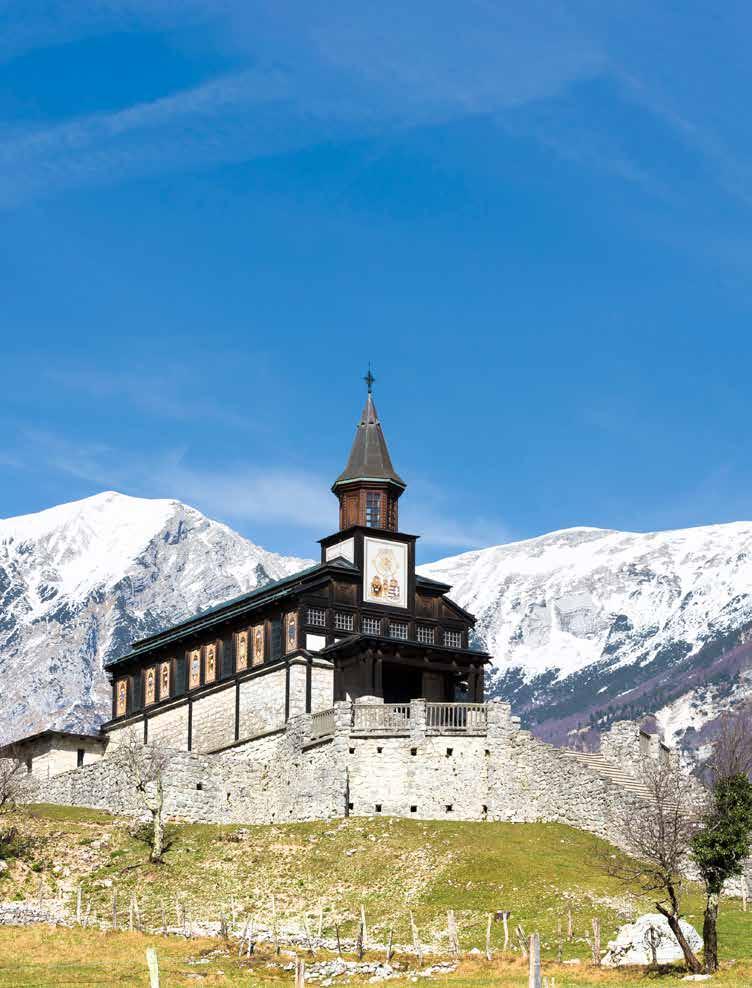

A long-distance trail in the area of the former Isonzo Front, one of the most famous battlefields in World War I, links natural attractions to the historical heritage of Slovenia and Italy. Learn the story of a soldier from the Isonzo Front, a unique experience bearing the Slovenia Unique Experiences label, at the Kolovrat Open-Air Museum and the Kobarid Museum. Along the way, you can visit several World War I museums, 21 open-air museums, numerous military cemeteries and ossuaries, and enjoy the peace and the breath-taking views from the Alps to the Adriatic. Owing to its mission and homage to peace, the Walk of Peace, with its World War I heritage on the territory of Slovenia, has also been inscribed on the UNESCO Tentative List of World Heritage Sites.
More than 500 kilometres; 30 stages 20 days for the Slovenian part of the trail; 12 days for the Italian part of the trail. All difficulty levels.
Log pod Mangartom Kranjska Gora Bohinjska Bistrica Tolmin Kobarid Bovec Šmartno Nova Gorica Šempeter Renče Komen KanalAmidst the Karst phenomena of the Dinaric Alps
One of the most interesting hiking trails in Europe starts in Slovenia and ends far to the south, passing through the Balkan countries in stages. The Slovenian section of the trail leads among exceptional Karst sites: the underground world of Križna and Planina caves, the intermittent Lake Cerknica and other extraordinary water phenomena, the ancient beech forests which are part of the UNESCO World Heritage, and a unique cultural heritage. The highest peak on the trail is Mt Snežnik (1796 m).
Duration: 6 days
Length: 160 km (in Slovenia)
Difficulty: easy to medium difficulty
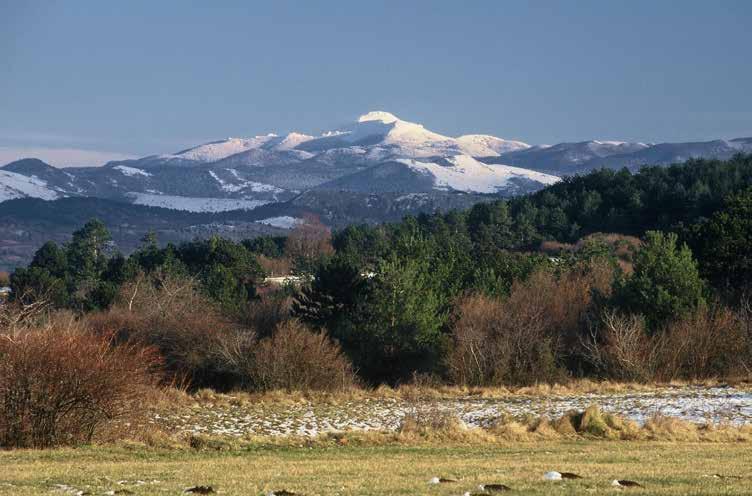
From the Kozjansko Regional Park to the hills above the Sava River
The UNESCO Biosphere Reserve of the Kozjansko Regional Park, known for high-trunk meadow orchards, the scenic Posavje Hills above the Sava River and the Geometric Centre of Slovenia (GEOSS) are all on the route of the Zasavje Long-Distance Trail, which is also suitable for hiking in winter. There are several mountain huts and inns on the trail, too. Among the attractive destinations is the trail’s highest peak, 1,220-metre-high Kum, which commands views reaching to the Julian Alps and Mt Triglav.
Duration: 7 days
Length: 200 km (in Slovenia)
Difficulty: easy
 Mt Snežnik
Kozjansko
Mt Snežnik
Kozjansko
Circular trail through three mountain ranges
You can walk the Meža, Drava and Mislinja valleys and the ranges of the Karavanke Alps, the Pohorje and Kozjak hills, and the Kamnik-Savinja Alps. The trail may be divided into shorter and easier stages or hiked in one challenging tour that takes between ten and twelve days. You may be tempted by the K24 endurance challenge: to climb the five highest Koroška peaks in 24 hours, i.e. Uršlja gora (1699 m), Smrekovec (1577 m), Raduha (2062 m), Olševa (1930 m) and Peca (2125 m).
Duration: 10–12 days
Length: 230 km
Difficulty: medium difficulty
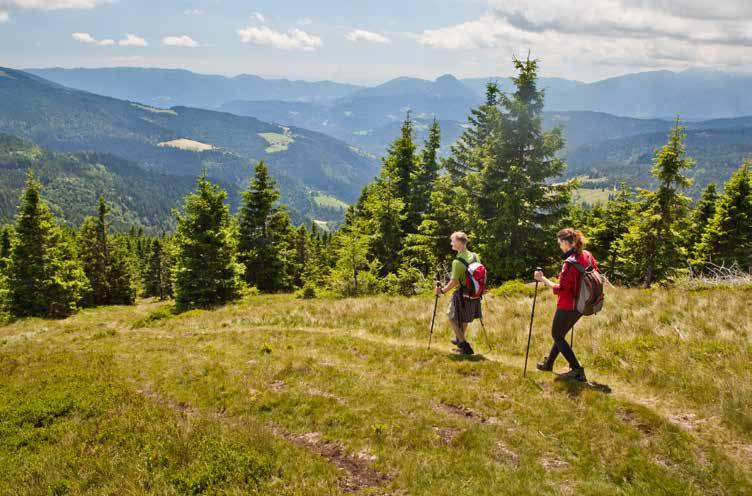
Smrekovec

On light feet among thermal springs
In eastern Slovenia, where the largest number of natural health resorts can be found, the hiking trails are suitable for everyone. Choose your stage among the fields, orchards, vineyards and forests of the Goričko Landscape Park. Discover biodiversity and numerous animal species. Enjoy the Prekmurje hospitality and cuisine. Learn about the Mura River and the wineproducing regions and hills of Radgonsko-Kapelske gorice, Jeruzalemske and Lendavske gorice.
Duration: 20 stages
Length: 330 km
Difficulty: easy
Selo, GoričkoBovec
Kobarid

Korada
Šmartno
Kranjska Gora
Jesenice
Žirovnica
Bohinj
Gorje
Bled
Radovljica
Tolmin
Solkan
Circular long-distance trail of grand views under Mt Triglav
This trail featuring authentic encounters with residents of the Alpine villages and towns leads you around Triglav National Park and the UNESCO Biosphere Reserve of the Julian Alps. With its new stages, the trail extends from the Posočje region into the picturesque and colourful wine producing Goriška Brda Hills. Although it does not exceed a height of 1,326 metres, the trail is distinguished by its exceptional vistas over the highest Slovenian peaks and offers an opportunity to discover the rich natural and cultural heritage of the amazing Alpine world. Selected stages are suitable for easy family trekking, and their starting points are in locations with good bus and railway connections.
This trail was recommended by The Guardian and the New York Times. 330 kilometres 20 stages
Average stage length:
17,5 kilometres (4 – 5 hours of walking)
Easy to medium difficulty
Zelenci, Kranjska GoraRegardless of your fitness level, you can get to know Slovenia on foot. More than 700 themed trails provide a wealth of the diverse natural and cultural features that are a hallmark of the country at the meeting place of four geographical worlds. Plan easy walks and treks along themed trails and make your active holidays more interesting. Everything is close in Slovenia. You can venture on these themed trails, which are usually emblazoned with yellow-white markings, using regular hiking equipment. Below are a few tips for hiking in the different regions of Slovenia; but in reality, the options are limitless. Contact tourist information centres in Slovenia for more information and they will advise you on additional seasonally appropriate trails suited to your preferences.

This natural history educational path with hanging footbridges and 17 information points links the emerald Soča River with the mysterious corners of the Trenta Valley and the sights of Triglav National Park.
Trenta 25 km 7 hours in one direction It’s possible to walk only the chosen section.
Visit the only Slovenian confluence of gorge-channelled rivers. At the confluence of the Tolminka and Zadlaščica rivers, you can admire the stony Bear's Head, the Devil's Bridge 60 metres above the water and Zadlaška (Dante's) Cave.
Tolmin 2 km 1 hour 30 minutes
This trail leads from the Slovenian Alpine Museum, past the Peričnik Waterfall, through the Alpine Vrata Valley with the Aljažev dom mountain hut right under the Triglav North Face, one of the most majestic in the Alps, measuring more than 3,000 metres in width.
Mojstrana 10 km in one direction 2–3 hours
After admiring the most beautiful vistas of Lake Bled, venture to Vintgar Gorge. An educational trail running along vertical cliffs and by the Radovna River is set on wooden bridges and galleries.
Podhom 4 or 5 km 2–3 hours
In addition to the trail along Lake Bohinj, amidst the mountains of Triglav National Park, and past the Savica Waterfall, you can also discover the trail along the Mostnica River Gorge. Admire its pools along the gorge from four bridges, and continue your hike along the Voje Valley.
Stara Fužina 3 km 1 hour 30 minutes
An easy hiking tour to the quaint ruins of Kamen Castle will take you past Old Iron Age archaeological sites (Njivice and the Zijalka Cave) and the karst cave called the Devil’s Manor House.
Begunje 7, 7 km 2–3 hours
This multi-awarded themed path connects the birthplaces of prominent Slovenian poets, writers and linguists, including the memorial apiary of Anton Janša, the pioneer of Slovenian beekeeping.
Vrba 10 km 2–3 hours (without visiting the museums)
A mountain backdrop and the rising full moon above the church atop the 831-metre-high Jamnik makes for a well-known motif for photographers from around the world and a popular hiking destination.
Nemilje 6 km 2 hours in both directions
There are six sections among several paths at the Palaeozoic fossil site that lead through the narrowest part of the gorge to the steep rock pyramids and the Dolina exhibition and educational centre.
Tržič 4,2 km 2 hours

In the Cerkno Hills, a path along two streams with several waterfalls will take you to the 16 buildings of the exceptional Franja Partisan Hospital in the Pasica Gorge. This authentic monument to humanity has been proposed for inscription on the UNESCO World Heritage List.
Cerkno 10 km 3 hours 30 minutes Franja Hospital
The best thematic trail in 2021 takes you through the special features of the famous glacial valley to the picturesque Rinka Waterfall. Also visit the highest located Slovenian farmsteads on the Solčava Panoramic Road, the route with the most beautiful views.
Logarska dolina 7 km 2–3 hours
Among the numerous options to be experienced in the Pohorje Hills, don’t miss the path that leads to the footbridges above the clean, but dark waters of Black Lake and its forest reserve. Continue to Osankarica, the site of an important battle during the Second World War.
Trije Kralji 3,5 km in one direction 1 hour 30 minutes
In the town that boasts the oldest vine in the world, where vine-growing hills extend practically to the town’s centre, the Piramida–Kalvarija natural history educational trail will take you to places with beautiful views over Maribor, the Drava River and the Pohorje Hills.
Maribor City Park 5 km 2–3 hours


In addition to numerous trails in the Tivoli, Rožnik and Šišenski hrib Landscape Park, it’s also possible to ascend the Šmarna Gora Hill from the green capital. This hill, which commands views of the entire Ljubljana Basin and the Alps, is also considered to be the venue for the best mountain running races in the world.
Tacen, Vikrče, Šmartno and several other starting points 23 different paths 1 -2 hours in one direction
Customs and traditions, architecture, natural and other sights of the famous shepherd mountain pastures are showcased on the trail by means of eleven information points. You can access the plateau by cable car or many mountain trails.
Velika planina 6,7 km 2 hours 30 minutes
Go barefoot on one of the best themed trails in Terme Snovik. For a therapeutic effect, the trail will take you on grass, forest and other surfaces laid with natural material.
Terme Snovik 3,2 km 2 hours 30 minutes
A trail connecting mountain villages and the valley, providing beautiful vistas over the Kamnik-Savinja Alps. In addition to the cultural heritage of Adergas, the Velesovo Convent and the Štefanja gora Hill, you can also discover natural assets and the ethnological heritage of Cerklje na Gorenjskem.
Adergas 4 routes, the longest one is 11 km 3 hours

On a trail that runs right next to the Kolpa River, you will find a water spring considered to be the spring of eternal youth, an operating mill, the Kobiljača Karst Cave, and the picturesque village of Damelj, the southernmost point of Slovenia.
Radenci v Beli krajini 11 km in one direction 3 hours
This circular trail leads through the most forested region of Slovenia where you can also catch a glimpse of the UNESCO-protected Krokar primeval forest. From the trail marked with a symbol of a daffodil, it’s possible to descend to the Kolpa River Canyon.
Borovec 7 km 2–4 hours

Enter into the world of the mysterious Kočevsko forests where nature is still preserved in its pristine state. This is the region with the largest population of brown bears and the largest extent of old-growth forest remaining in Europe. Join the research expedition and step onto the migration paths of the brown bear. Lead by an experienced local guide, you will experience the wild spirit of the Kočevsko forests. See the "king" of the Kočevsko forests up close and try the unusual, yet edible forest herbs.

Kočevje 8.5 hours | Season: April–October | Guided experience
Follow the markings featuring an image of a medieval pageboy from Loka Castle, towering above the old town centre of Škofja Loka, to the ruins of the Tower on Krancelj. Cross the Kobila Pass through natural gullies and explore the ruins of Divja Loka Castle on the steep slopes of Lubnik.
Škofja Loka 5 km 1 hour 45 minutes
Near the surprising Divje jezero (Wild Lake), set off on the route of the Feldbahn - a narrow-gauge railway from the First World War with an altitude difference of 300 metres and a 25-metrelong tunnel. A longer version of the route takes you to Godovič. Parking lot near the Divje jezero (Wild Lake) 10 km 2.5 hours
Velika planina Kočevsko
When visiting the UNESCO-protected Škocjan Caves, which have the largest known underground canyon, take a walk along the educational trail where you can learn about the phenomena of the Classical Karst at 24 information points.
Škocjan Caves Park Information Centre
2 km 1 hour
When on a walk in the Karst valley of the Notranjska Regional Park, you will be astounded by the natural arches of the Big and Little Natural Bridges, flood meadows by the Rak Stream and the characteristic Karst flora and fauna.
Rakov Škocjan - car park at the Little Natural Bridge
5,5 km 3–4 hours
After opening in 2020, this trail with exceptional views of the unique Lake Cerknica was declared the best thematic trail of the year. Lookouts, of which one is a 10-metre-high Otočec tower, make this hike in the area between the Rešeto sinkholes and the village of Otok even more interesting.
Dolenje jezero car park 3,7 km in one direction
3.5–4 hours
A visit to the Park of Military History, the largest museum complex in Slovenia, can be upgraded with a hike to the underground fortification on a hill offering scenic vistas over the Pivka Valley.
Park of Military History Pivka 1,3 km 4 hours
Over 20 kilometres of themed and hiking trails are arranged between Sežana, Lipica and the Slovenian-Italian border where, in addition to the Karst phenomena, natural rock formations and Gustinčič Cave, you can also learn about the dry stone walling protected by UNESCO.
Sežana several paths 2–4 hours
The trail, part of the Slovenian Mountain Trail, will take you to attractions such as the Karst Otlica Natural Window and the spring of the Hubelj River. The views to be enjoyed on this trail along the edge of the iconic Vipava Valley reach across the Karst and all the way to the sea.
Predmeja 14,3 km in one direction 5 hours
From the Renaissance Dobrovo Castle, walk to the panoramic tower in Gonjače and to the medieval village of Šmartno. You’ll learn about the unique architecture, cuisine and world-renowned cellars of the Goriška Brda Hills.
Dobrovo Castle| Length: 9.5 km 2.5–3 hours
Lake Cerknica, the Bloke Plateau, the Karst Edge and the Dragonja River Valley are some of the most biodiverse regions of Mediterranean & Karst Slovenia. You can learn about them with the help of a natural science guide who will reveal secrets of the Karst phenomena, flora and fauna, and also the life of the brown bear. Along the way, you’ll also enjoy the hospitality of tourist farms and taste the flavours of locally produced food.
4 days (3 nights)| Guided experience

Among the numerous trails found in the Slovenian Istria, you can choose one that takes you to the panoramic Slavnik and its Tuma mountain hut. Along the way you can admire an abundance of mountain flowers, as well as vistas of the Adriatic Sea, the Julian Alps with Mt Triglav and the Italian Dolomites.
Podgorje | Length: 8 km 2.5–3 hours
On the educational trail in Strunjan Landscape Park, you can learn about the northernmost salt pans of the Mediterranean, a special sea lagoon, the Strunjan cliff and other sights of the Slovenian coast.
Strunjan Landscape Park Centre
5,3 km 1 hour 30 minutes
An easy trail connecting lively Portorož with medieval Piran which offers the most photogenic views among all the Piran circular trails. The trail that encircles the town leads right next to the sea for the most part.
Portorož 9 km 2 hours 30 minutes
On the Brkini ridge, in the Mythical Park you will meet carved sculptures with motifs representing the narrative tradition of this interesting part of the world. The app invites us to solve puzzles along the way.
Rodik 6.5 km 2.5 hours
Interpretation exhibition at the Rodik Mythical Park Visitor Centre
Starting point Length Time
Circular trail
Entrance fee
This trail leading along the junction of the Pannonian Plain and the Goričko Hills is characterised by vineyards and wineries. When walking from Tešanovci to Moravske Toplice, you can savour tasty food from providers of local delicacies.
Tešanovci 12 km 3–4 hours
You’ll never forget this trail among the iconic vineyards of the Jeruzalemske Gorice Hills and the tasting of supreme white wines in vineyard cottages and local cuisine prepared at tourist farms and inns.
Jeruzalem 8 km 2 hours 30 minutes
The international Nordic Walking trail among the vineyards connects Slovenian and Austrian wine-producing farms and sights of interest, such as the famous heart-shaped road among the vineyards with awe-inspiring views at Špičnik.
Svečina 5 trails with distances ranging from 11 to 23 km 3–6 hours
Views of the oldest Slovenian town are the most beautiful from the peaks around it. Awaiting you along the way are the Roman Camp Poetovio, hospitable agritourism farms and winegrowers, the Old Press Museum and the Railway Park.
Ptuj Thermal Spa or the old centre of Ptuj 15.9 km 3 hours
Among the numerous hiking trails in Laško, a town known for its health resort and brewing, there’s one that connects green nature with the region’s sacral heritage. The oldest organs in Slovenia can be found in one of the churches along the way.
Laško 6,6 km 2-3 hours
This trail in the valley of the green gold between Žalec and Šempeter takes you among hop plantations to the Eco-Museum of Hop-Growing and Brewing Industry and the first beer fountain in the world.
Žalec 14 km 3–4 hours
Set out from the medieval market town of Podsreda near the health resort of Podčetrtek in the Kozjansko Regional Park, past the Levstik Mill and through the forest at Podsreda Castle, considered to be the most stately of all Slovenian castles.
Podsreda 2.5 km in one direction
45 minutes

Walk from waterfall to waterfall. Climb a few rocks at Bojanca Waterfall and then descend to the multi-levelled Pekel Waterfall. Go on further to the Ubijavnik Waterfall and its pool, and then to Bojavnik Waterfall. The trail offers a medium level of difficulty.
Krško: Jablance 12,5 km 6 hours
The trail along which the Trappist monks once transported wine from Sremič offers a view of the entire Krško polje basin and the Kamnik-Savinja Alps from the Grmada Hill, the highest point on the trail. Among the vineyards, you can visit several churches and Rajhenburg Castle.
Brestanica 12 km 4 hours
In addition to many other trails, the health resort known as the centre of Nordic walking enables a hike to Otočec Castle, the only castle on water in Slovenia. You can walk from the island in the middle of the Krka River to nearby Struga Castle, too.
Šmarješke Toplice 12 km 3 hours
The trail links promenades by the Krka River, town forests, Grm Castle and its park, the Kette Avenue, the archaeologically important Marof Hill and other green sights of the Dolenjska capital. The views also reveal why Novo mesto is known as the town on seven hills.
Novo mesto 10,5 km 2 hours 30 minutes
In the town of the renowned Counts of Celje, you can venture on educational forest trails that lead to the largest tree house in Slovenia. Visit a special adventure playground and view the town next to the Savinja River from an observatory.
Celje 14 km 12 different trails
Discover the attractions of the health resort known for its spring water rich in magnesium. The trail starts and ends in the iconic spa park, leads to four different springs, the mineral water hall and other attractions in Rogaška Slatina.
Rogaška Slatina 5 km 2 hours
Starting point Length Time
Circular trail Entrance fee
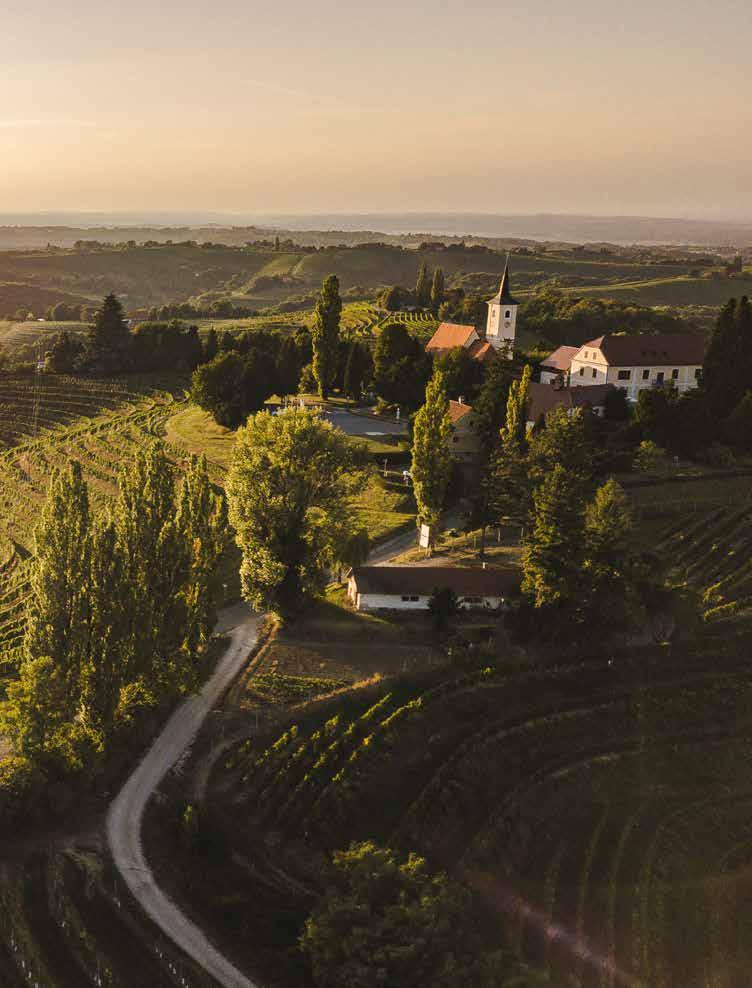
Go on a 3.2-kilometre fairy-tale and adventurous trail in Ljubljana Marshes Nature Park where you will find sculptures of marsh animals. Children can collect swamp stamps and pixierunic symbols in their Marsh Notebook.
The Best Themed Trail of 2019 invites you to the Šalek Valley, where you’ll experience the relaxing power of the forest, milling, legendary stories of Snake Castle and various antiquities preserved in a special collection.
Accompanied by giant wooden animals, the cheeky dwarf invites you to discover treasures in the natural surroundings of the Pohorje Hills. With the help of virtual reality, it even pops up every now and then and speaks to you.
After travelling to the plateau in the middle of the KamnikSavinja Alps by cable car and a four-seater chairlift, you’ll venture through forests and across pastures to the dwarf’s garden, a shepherd’s cottage and the mountain of sounds. Along the way, you’ll solve the tasks collected in the dwarf’s scrapbook.
The natural history educational trail named after an unruly bird hides many surprises on a 5.2-kilometre hike near Ljubljana where you’ll encounter numerous birds and enjoy their singing, learn about the wildlife in ponds and in Županova jama (Mayor’s Cave).
In the park next to the Polhov Gradec Manor, with the Polh booklet in your hand, set off on a circular route among wooden sculptures of forest animals, to the didactic apiary, the Animal Mail House and the Jazbina Den. In the meantime, you can get to know the nature and culture of Polhov Gradec.

On wooden paths among the trees
Rogla has long been an attractive hiking destination for discovering the Pohorje Hills. Along wooden footbridges laid among 19 lakes, you can explore the raised bogs of the Lovrenc Lakes or opt for a completely new way of experience: it’s now possible to admire the Pohorje forests from 20 metres above the ground. After walking 522 metres on the wooden construction, you will reach a 37-metre-high tower with an internal path stretching for 521 metres. You can descend from the tower on a slide.
1,043 metres of paths among the treetops 37-metre-high observation tower offering views of the highest mountains
Adrenaline and educational stops along the way 63-metre-long slide
All year round for all generations
Path accessible to wheelchairs and pushchairs
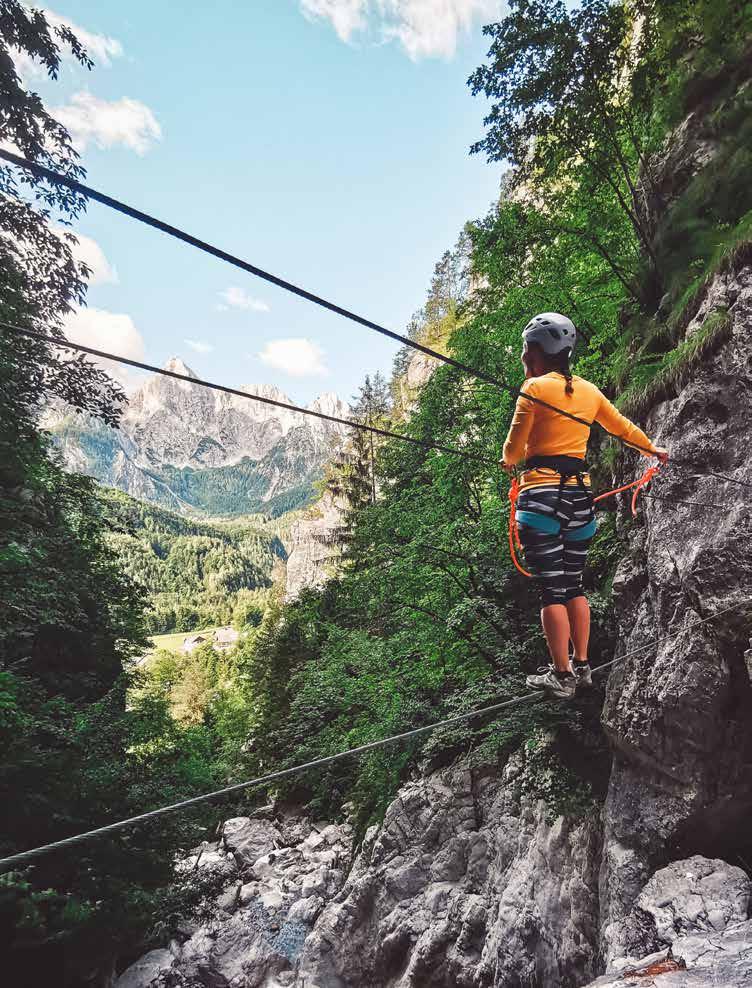
A popular adrenaline experience among experienced hikers who seek special thrills are ferratas; maintained and protected climbing routes. Classic ferratas are equipped with pitons and steel wires to help climbers reach their destinations more safely, while modern sports ferratas are designed to provide excitement when climbing in nature.
Attention! Climb safely. Use protective equipment: a helmet, a climbing harness, a self-protection set, and climbing footwear with a good grip. Assess your abilities regarding the level of difficulty graded from A to F. A course is mandatory for higher difficulty levels, on which you’ll learn suitable climbing techniques and correct use of the equipment. If you’re climbing a ferrata for the first time, take a guide with you.
KRANJSKA GORA, the Hvadnik Via Ferrata
Difference in altitude: 250 m
Difficulty: B, detail C
MOJSTRANA, the Grančišče Via Ferrata
Difference in altitude: 180 m
Difficulty: 2 routes; B and C, C/D
TRŽIČ, the Spodnji Plot – Zelenica Via Ferrata
Difference in altitude: 90 m
Difficulty: bottom section A/B; then 2 routes; D and E
JEZERSKO, the Češka koča Via Ferrata
Difference in altitude: 300 m
Difficulty: C/D, detail E
POSAVJE, the Lisca Via Ferrata
Difference in altitude: 125 m
Difficulty: B/C, last stretch D/E
VINSKA GORA, the Gonžarjeva Peč Via Ferrata
Difference in altitude: 125 m
Difficulty: B/C, detail D/E
VRŠIČ, the Hanza Route to Mt Mala Mojstrovka
Via Ferrata
Difference in altitude: 720 m
Difficulty: B/C
KANIN, the family-friendly Mt Prestreljenik
Via Ferrata
Difference in altitude: 110 m
Difficulty: A
Slovenian mountaineers have been conquering primary routes on the highest mountains of the world for decades. Among the most popular ones in Slovenia is the 1,300 metres high and more than 3,500 metres wide Triglav North Face, where more than 140 routes have been marked which can be discovered in the summer if you are suitably skilled and equipped and accompanied by experienced guides. Challenging rock faces can also be found in other mountains of Alpine Slovenia.
Sports climbers wanting to climb even if they’re not conquering high mountain peaks can find in Slovenia natural climbing areas with a choice of routes of various difficulty levels. Most of them can be found in Alpine Slovenia, i.e. in the Julian Alps, and in the Jezersko region and the Logar Valley. Osp with its semi-circular overhanging rock face and routes with difficulty levels ranging between 4a and 9b attracts climbers all year round to Mediterranean & Karst Slovenia, including the nearby Mišja peč that boasts the most difficult climbing routes. A popular climbing area in Thermal Pannonian Slovenia is Kotečnik in the vicinity of the hop-growing town of Žalec, where more than 300 routes for beginners and expert climbers can be found between spring and autumn.
Slovenian climbers are some of the best in the world. They have good training conditions in nature and climbing centres. The largest and most modern sports and climbing centre in Ljubljana has almost 1,300 m2 of climbing surfaces with high and low or bouldering walls and routes of various difficulty levels. The climbing centre in Celje has a wall for speed climbing and the centre in Kranj a wall for lead climbing. The centres for bouldering are also in Verd near Vrhnika, Koper and Nova Gorica. Climbing walls can also be found in sports centres and schools. Also offering interesting challenges are artificial outdoor climbing walls, which can be found, for example, in the Cukarca Adventure Park near Šentvid pri Stični and in Gozd Martuljek.

365 days of opportunities for cycling: the geographic and climatic diversity from the Mediterranean to the Alps and the Karst to the Pannonian Plain

More than 10 long-distance cycling trails 11 mountain biking parks
More than 50 specialised accommodation facilities for cyclists
Find more information on the website. Set up your active holiday programme. Choose your accommodation and experience more.

Alpine Slovenia invites visitors to experience excellent cycling parks in the summer and mountain biking trails of all difficulty levels. Thermal Pannonian Slovenia features friendly trails for family cycling trips along the plains near rivers and gentle rural hills and routes for road cyclists. Ljubljana & Central Slovenia prove that a bike is an excellent choice for travelling distances in towns and discovering stories along themed cycling trails. Although die-hard cycling enthusiasts also cycle in winter in Slovenia, it’s best to venture on cycling tours between spring and autumn. The exception is Mediterranean & Karst Slovenia, where it’s possible to cycle throughout the year due to the mild climate.
All selected cycling trails can also be cycled by e-bikes. These can be hired from specialised tourist agencies, while tourist information centres (TICs) and certified accommodation facilities for cyclists provide information about local offers.
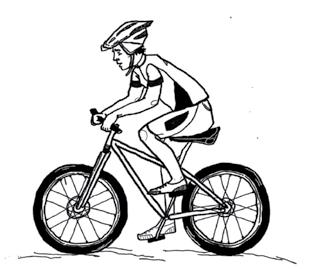
Explore the surrounding area of holiday destination and towns on family trips with your own or rented (including electric) bikes. You can set out from Slovenian natural health resorts on maintained and marked easy trails along plains and hills. Trails attracting beginners as well as experienced cyclists can also be found in mountain centres that provide an array of other sports and outdoor activities for active families. Marked cycling tours challenge road cyclists with elevation differences and provide magnificent views, while forest trails and bike parks inspire tour and gravity mountain bikers and adrenaline junkies. Cycling travellers prefer long-distance cycling trails that connect several regions.
The fact that Slovenia is a cyclist-friendly country is supported by more than 50 specialised providers of accommodation for cyclists. Hotels, hostels, guesthouses, apartments and other types of accommodation adorned with one, two, three, four or five bikes offer their own cycling tours and guides, bike rental and service, transport, etc. in addition to safe storage facilities for bicycles. When choosing your accommodation, don’t forget to look at camp sites especially designed for accommodating cyclists. In addition to useful information and services, these also offer multi-day cycling tour programmes and trained cycling guides.
Kranjska Gora
Bovec

Slovenj Gradec
Škofja Loka
Trbovlje
Ljubljana
Ajdovščina
Koper
Brežice
Kočevje
Ilirska Bistrica
Length: 1,800 km
Difficulty: medium difficulty
The diversity of Slovenian regions can be explored on this 1,800-kilometre long route with 50,000 metres of elevation difference and 109 control points at 41 stages for which GPS tracking is available. This circular route that connects all the major Slovenian mountain ranges by means of skid trails and paths, field trails and side roads includes 50 mountain huts and important aspects of mountaineering, ethnographic and technical history.
A diverse 75-kilometre route linking the sports centre of the Maribor Pohorje Hills with those of Areh, Rogla, the Ribnica Pohorje Hills and Kope. The starting point or the end of the route in the Maribor section is at the upper station of the Pohorje funicular and at the Kremžar Vrh Hill above Slovenj Gradec in the Koroška section. The entire Pohorje Hills are intertwined with numerous cycling trails, many of which are connected with the attractive transversal.
Length: 75 km
Difficulty: medium difficulty
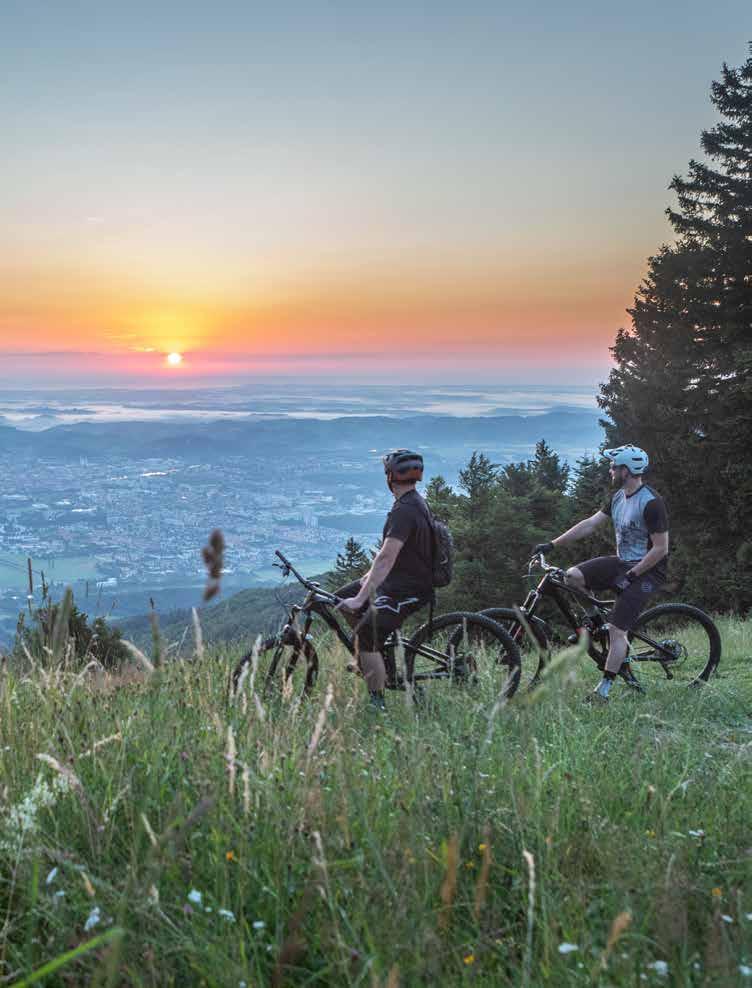 Bolfenk
Areh Rogla
Ribniško Pohorje
Kope
Kremžarjev vrh
Bolfenk
Areh Rogla
Ribniško Pohorje
Kope
Kremžarjev vrh
Length:

Difficulty: medium difficulty Length:
Experience exceptional diversity on the 384-kilometre long mountain bike tour, Trans Slovenia 1, which links three countries: Slovenia, Italy and Austria. The trail will take you from the Julian Alps through the picturesque Soča River Valley to the green hills of the Brda region, and then through the Vipava Valley and across the mysterious Karst to the coast. Awaiting you along the trail, which is divided into seven daily stages, are local delicacies and interesting and sometimes shocking traces of the past.

The Karavanke Alps, the longest Slovenian mountain range, stretching along the Slovenian-Austrian border, is 132 kilometres long. It stuns mountain bikers with its trail through an awe-inspiring landscape offering majestic views. The trail from the Jezersko Valley to the Triple Border (Tromeja) in the far northwestern part of Slovenia is suitable for physically fit cyclists. It is divided into five daily stages between 25 and 35 kilometres in length. The largest elevation difference in one day is 1,650 m.
The Juliana Bike Mountain Biking Loop, with seven basic access stages and three additional access stages, runs through the UNESCO Biosphere Reserve of the Julian Alps and also extends into the Triglav National Park. Set off on a journey on local roads, cycling paths, forest trails or cart tracks while paying respect to nature, sensitive habitats and the life of the locals in the Julian Alps. The well-marked Juliana Bike is also part of the Slovenian Long-distance Cycling Route.
Length: 290 km
Difficulty: medium difficulty
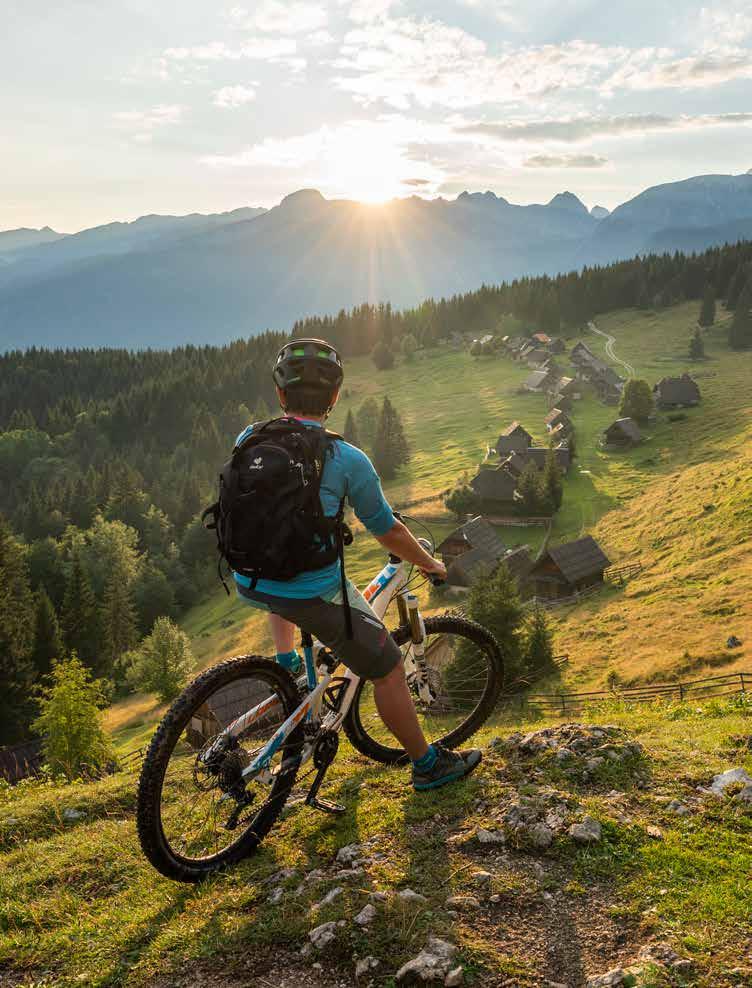 Kranjska Gora
Bovec Kobarid
Žirovnica
Jesenice
Bled Gorje Radovljica
Brda Bohinj Tolmin
Kranjska Gora
Bovec Kobarid
Žirovnica
Jesenice
Bled Gorje Radovljica
Brda Bohinj Tolmin

The Bike Slovenia Green cycling tours only connect destinations that prove their commitment to a green future by attaining the Slovenia Green sustainability certificate. The Gourmet Tour includes places for culinary pampering, the tour from the Alps to the Adriatic Sea through the Soča Valley and through Goriška Brda also leads to the seaside cycling path on the former Parenzana railway line, while the third tour invites you among the special features of Ljubljana and central Slovenia, Kočevje and Bela Krajina. You can go on tours with guides or with the help of GPS tracking.
Bike Slovenia Green: Gourmet Route
Length: 359 km - 479 km
Difficulty: medium
Bike Slovenia Green: Alps to Adriatic
Length: 255 km
Difficulty: easy
Bike Slovenia Green: Capitals Route
Length: 174 km
Difficulty: easy

Those who travel on a mountain or a trekking bike find the right trails for themselves either on famed long-distance trails or their selected stages as well as in numerous local cycling networks. Explore green nature in the vicinity of historical towns and regional or landscape parks. Ascend to see views that may surprise you even on lower hills and not just atop Alpine peaks.
Enjoy the views from the peaks of the Julian Alps between Bovec, Tolmin and Kobarid, and explore iconic plateaus and remote villages. This trail along the ridge of Kobarid’s Mt Stol (ascent to 1,246 metres) is considered to be one of the most scenic experiences. The trail to Mt Matajur (1642 m) is challenging, while the cycling trails by the easternmost Slovenian village, Robidišče, are very inspiring.
In addition to more than 200 kilometres of cycling paths suitable for all cyclists, mountain trails can also be found in the popular mountain sports centre. After strenuous climbs to mountain ridges, enjoyable descents are guaranteed.
Close to the town renowned for its unique Passion Play, numerous cycling trails along the hills of three valleys have been arranged. The almost 400-kilometre Loka Cycle Route, divided into 13 stages, offers picturesque vistas. On one of the stages, you can climb to the top of Mt Blegoš (1562 m).
The town once known for its shoe-making industry features as many as 30 marked trails with destinations such as Mt Košuta, Slovenia’s longest mountain, Mt Storžič, Mt Kriška gora or Mt Dobrča. The Ljubelj road pass with its iconic gorges and river valleys can pose quite a challenge for cyclists.
A circular cycling tour through the Vipava Valley, which begins and ends in Ajdovščina and, after a visit to Vipava and an 800-metre ascent to Col, opens up views from the edge of the Trnovski Gozd plateau. A track that climbs to the popular Nanos plateau (1,240 m) also branches off from the path.
You can explore UNESCO’s Karst Biosphere Reserve and venture to the iconic Brkini Hills via the hills and valleys along the 24-kilometre Brkinka Trail. Special features of the Green Karst can be seen on the Land of the Bear Cycling Trail that will take you to Snežnik Castle and Karst caves.
Cycle to Mt Velika Slivnica (1114 m) to find the most magnificent views of the intermittent Lake Cerknica. Discover other surprises of the Notranjska Regional Park in the Rakov Škocjan Valley and on the Menišija Cycling Trail.
You can cycle here among the water springs with information boards and maintained picnic areas along the way. The shorter Springs of Kočevje Route, which also includes the Rožni Studenec Forest Educational Trail, is 14.5 kilometres long and suitable for everyone. In addition to springs and other sights, the longer and somewhat more difficult route takes you on its 31 kilometres to the MTB Trail Centre Kočevje.
Put your bike on a cable car and descend to the famous Velika planina Plateau from where you ride into the valley along a 29-kilometre trail. The attractive trail along the Solčava Panoramic Road can be found near the Logar Valley, where you can admire views of one of the most scenic glacial valleys in Europe. On the Golte Plateau, you can cycle past one of the highest situated mountain gardens in Europe, the Alpine Garden, high mountain Karst gullies and shepherds’ huts to nearby Smrekovec, the only (extinct) volcano in Slovenia.
Ljubljana plans to become the first capital in Europe with attractive trails for mountain bikers in an urban environment. Explore the Golovec Trails with natural single trails, plus challenging and fun trails for climbing.
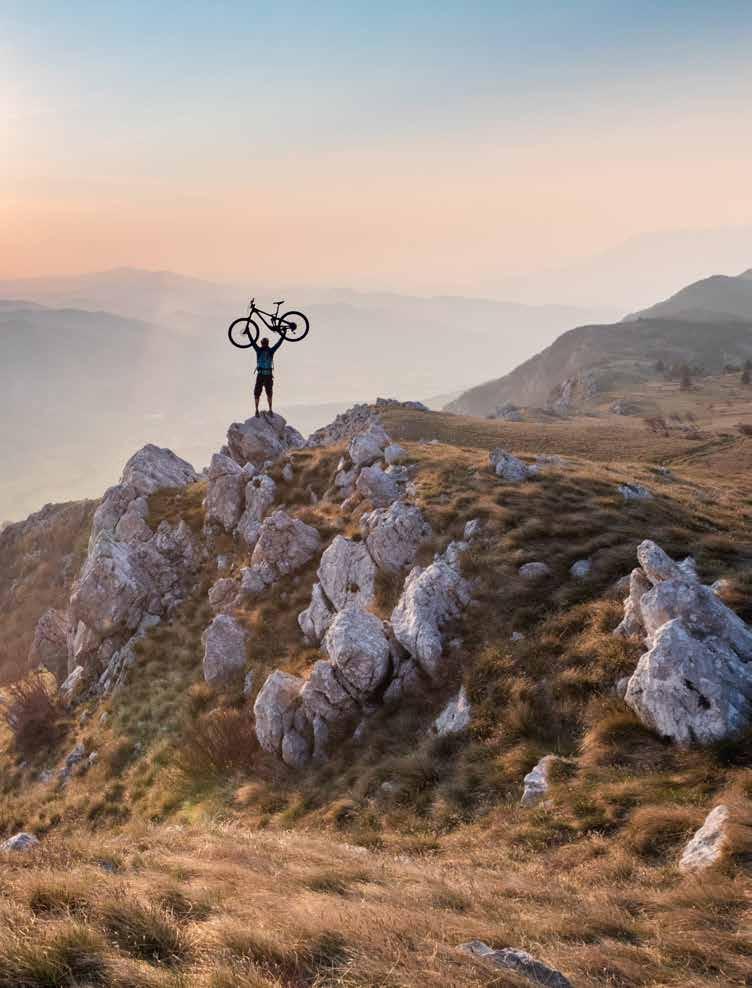

Cyclists on bikes named "all-mountain" and "enduro" can enjoy 21 kilometres of single trails in the Koroška park. Less difficult and technically challenging trails are linked together with a special trail to facilitate the return to the top. The mountainous surrounding area attracts MTB bikers as they can descend the neighbouring Mt Peca along a trail with 1,000 metres of elevation difference, considered to be the longest flow trail in Europe.
For their dose of adrenaline, beginners can choose the 5.5-kilometre blue flow and family line with small jumps. The advanced and more skilled bikers challenge themselves on the 2.9-kilometre super-fast red line with huge jumps, while pro bikers ride the legendary 2.1-kilometre black line of the World Cup with its technical jumps.
On the iconic ski slope in the heart of the Julian Alps, accessible via a four-seater chairlift, a bike park for all types of bikers (free ride, northshore, enduro, tabletop, downhill) of various physical fitness levels has been set up. Families and beginners, experienced and professional mountain bikers can also venture on trips and regular tours of the surrounding hills.
Choose from 30 kilometres of trails on six marked mountain biking trails with the largest elevation drop among the Slovenian bike parks. The park enables the perfection of skills on wooden and rock elements which can be practised on the trail for beginners and on the panoramic trail.
The natural ski slope in Triglav National Park attracts adrenaline bikers in summer. The access to the start altitude at 1,682 metres is enabled by a cable car and then a four-seater chairlift, both offering magnificent views. The 1.4-kilometre trail with an elevation difference of 200 metres and several obstacles of various difficulty levels is suitable for beginners and experienced bikers.
Five hand-made trails, each some 2 kilometres long, await you in the westernmost village in Slovenia. From the top, where there is also a skills park, they lead over the pools of the Nadiža River. The easiest routes are also suitable for families and children, while the more difficult ones require advanced knowledge.
In the midst of the Pohorje forests, bikers can enjoy the thrills provided by trails of various difficulty levels and elements such as tabletops, berms, drops, step ups, etc. The most difficult trails for super challenging descents with jumps and fast bends are particularly attractive. A park that attracts extra demanding bikers, it is also suitable for beginners who venture on the trails with instructors.
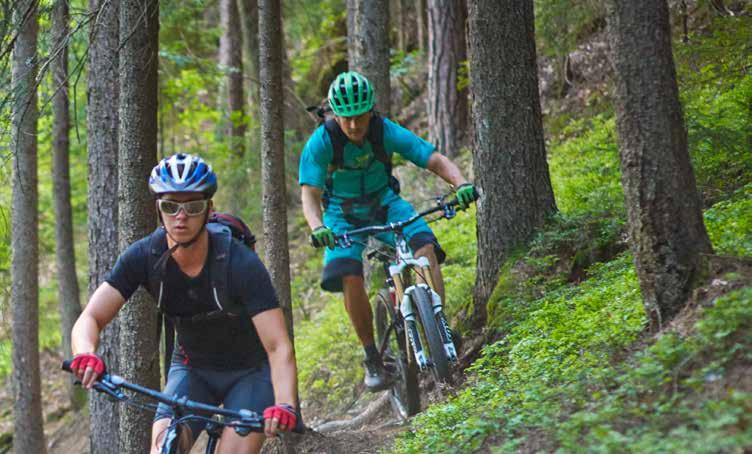
Dolga vas pri Kočevju is the place when several trails of various difficulty levels can be found, from the least demanding with no technical elements to the 3-kilometre climb with an elevation difference of 200 metres. Technical obstacles enabling longer jumps over holes, tests at a rock garden and on raised curves –berms can be found at the bottom of the park.
A trail for speed enthusiasts and a trail with a diverse course on natural ground with tilted turns can be found in the sports centre in Ravne na Koroškem.
The trail called Flow Line provides fun, sports and adrenaline adventures for individuals, groups and families, while the Pro Line is intended for the most skilled bikers.
A mountain bike skills park in an old quarry, a flow line and a dual slalom track, a pump track, options for jumps, and newly built facilities are linked by an XC trail. Educational workshops and courses are organised in the mountain bike skills park, which is also suitable for children and beginners.
The cycling part of the largest adventure park in Dolenjska offers two routes for beginners and experienced cyclists and an attractive "dirt park" with a dirt pump track and two jump lines. The park near Šentvid pri Stični also offers a large climbing wall and an adrenaline park.
Those who enjoy challenging slopes are familiar with 20-kilometre plus long climbs with elevation differences that demand respect. Although testing one’s own endurance is a good reason for choosing such trails, the true reward comes with the incredible views found at road passes and the changeability of the landscape along the way.

Many cyclists find the climb to Mt Krvavec above the Ljubljana Basin the toughest climb in Slovenia. The trail to the Hotel Krvavec includes 15.5 kilometres of persistent climbing with an average gradient of more than 8%, which even reaches 15% in two sections. The total climb stretches through 1,202 metres of elevation.
On an attractive road tour in the Julian Alps, a more than 21-kilometre slope has to be conquered on the way to the finish line at 2,040 metres. The route, which also leads through three tunnels, has on average a 7-per cent slope. After ascending 1,487 metres, you can see Mt Mangart (2678 m) and the Mangart or Laghi di Fusine Lakes.
A climb up to the highest road pass in Slovenia is demanding, but also a very popular cycling destination. If starting in Kranjska Gora, you’ll have to tackle a more than 10-kilometre climb with an average 7.25-per cent slope and 749 metres of elevation difference. The statistics are similar if starting on the other side of the pass in the Soča River Valley. A race in which competitors ride the legendary small city bike, Pony, to the Vršič Pass also presents a true challenge.
Wherever you are in Slovenia, a starting point for an interesting road climb is never far away. Cross the KamnikSavinja Alps across the Pavličevo Sedlo Pass and visit Solčava and the Logar Valley or the Jezersko Valley in the Gorenjska region. Push the pedals and conquer Golte or the Mozirje Hills. Venture on the Predel Pass on the border between Slovenia and Italy. Climb the forested Pokljuka Plateau to where trails lead from Bled and Bohinj. From the latter, you should also venture to Soriška planina road pass. Conquer the Pohorje Hills. You can start in Maribor and cycle to the Areh ski centre. In the Pohorje Hills, you’ll also discover the steepness of the road from the Zreče health resort to the Rogla ski resort. Ascend to Mt Kum in Central Slovenia. Tackle the road to Strmo Reber in the Kočevsko region, a challenging route with 19 180-degree hairpin turns and an average 8.8-per cent slope.
Trails along rivers and the Adriatic coast, between Alpine peaks and diverse Slovenian regions are an excellent choice for cyclists who enjoy the feeling of complete freedom while travelling. Individual stages of these trails provide perfect opportunities for short trips for cyclists of different fitness levels.

The international trail that begins at the source of the Drava River in Italy, continues through Austria, Slovenia, and ends in Croatia is 710 kilometres long. Its Slovenian section provides 145 kilometres of cycling challenges for fitter cyclists, but also sections suitable for everyone else. The route connects Maribor and Ptuj with a 30-kilometre stage suitable for family trips.
Length: 145 km (in Slovenia)
Difficulty: medium difficulty
Level: stages for all generations
Dravograd Radlje ob Dravi Maribor Ptuj OrmožThe famous coastal trail, also known as the Route of Health and Friendship, runs on the former narrow-gauge railway line between the Italian city of Trieste and Poreč in Croatia. It boasts views of the sea, the towns of Ankaran, Koper, Izola, Piran and Portorož, the Istrian vineyards and includes sections through tunnels. Due to the mild climate, it’s possible to venture on the trail any time of the year. Explore it in stages. The circular variant provides an abundance of experiences for a five-day trip. Parenzana is also popular among hikers.
Škofije
Ankaran
 Level: trail along the Adriatic coast
Length: 130 km
Difficulty: easy
Koper
Izola
Piran
Portorož
Portorož
Level: trail along the Adriatic coast
Length: 130 km
Difficulty: easy
Koper
Izola
Piran
Portorož
Portorož
Length: 115 km
Difficulty: easy
Level: stages for all generations
Bela krajina, the region of vine-growing hills, forests and white birches along the warm Kolpa River in south-eastern Slovenia, can be best experienced on a flat circular cycling and hiking trail. In addition to the circular trail, you can also choose from numerous themed cycling trails that lead to friendly inns and many natural and ethnographic sights near Črnomelj, Metlika and Semič.

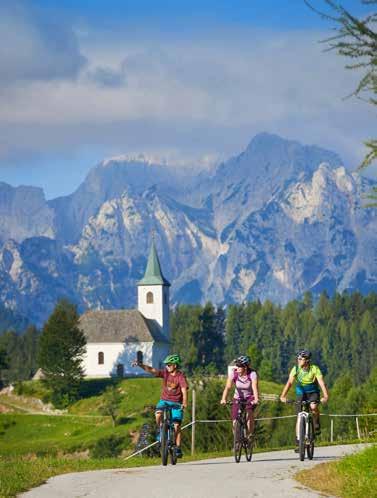
The circular trail around the Kamnik-Savinja Alps leads from medieval Kamnik under the Velika planina Plateau through Cerklje under Mt Krvavec and the Kokra River Valley to Jezersko in the high mountains and the Pavličevo Sedlo Pass and then across the Upper Savinja Valley back to Kamnik. While crossing three Alpine passes, you conquer 2,000 metres of elevation difference and enjoy impressive mountain views from the saddle.

Length: 56 km on the Mura’s right bank
Length: 78 km on the Mura’s left bank
Difficulty: easy
Level: stages for all generations
The riverside cycling trail that starts at the Mura’s spring in Austria reaches Slovenia and blossoms into the fabulous experiences offered by the picturesque Prekmurje and Prlekija regions. Thermal Pannonian Slovenia provides cyclists with hospitality, excellent local cuisine and wines and a break next to thermal springs. You will cross the river several times along the way and discover the natural and cultural attractions of the area.
Level: route over mountain passes Length: 130 km Difficulty: difficult Bela krajina Logar Valley Mura RiverIrrespective of your past cycling experience, you can safely explore trails in Slovenia which will take you to local roads and in special directions away from the main traffic routes. It’s easy to find the perfect trail for a family trip, exploration of towns and their green surrounding areas.

You can cycle around the iconic lake with its island in Bled. The Radovna River Valley between Bled and Kranjska Gora boasts unforgettable cycling trips for the entire family. You can start or end your journey along the first cycling trail in Triglav National Park at the Slovenian Alpine Museum in Mojstrana and explore along the way the sights of the Upper Sava Valley. From Bled, you can cycle to Radovljica, the centre of the Slovenian beekeeping tradition and chocolate-making, which is also a popular starting point for climbing mountains. In Kranj, considered to be the capital of the Slovenian Alps, venture on cycling routes under Mt Storžič. Four diverse trails will take you to vantage points of the Gorenjska countryside.
Cycling trails in the Brda Hills are named after fruit varieties growing in local orchards. Circular trips start in Dobrovo. An easy cycling trail suitable for the entire family can also be found in the Upper Vipava Valley. In addition to vineyards and orchards, it’s possible to discover attractions between the towns of Ajdovščina and Vipava where the only delta-shaped river spring in Europe can be found in the middle of the town.
Numerous cycling trails criss-cross near castles along the Sava River, which you can cycle on multi-day tours or short trips. Choose a route that will enable you to stop at castle cellars and restaurants so you can learn about the Posavje wine culture and cuisine. Themed trails near Terme Čatež Spa are also pleasant for easygoing cycling trips.
The valley of the emerald green Soča River offers more than 2,500 kilometres of trails for all types of cyclists. The road trail between Tolmin and Kobarid, which also runs on the Soča’s left bank away from the main road in the valley, is especially interesting for families. It leads through villages, past the Napoleon Bridge and the Soča gorges. The route from Kobarid to the Nadiža River and its swimming area is always a pleasant choice.
The Kozjansko and Obsotelje regions feature themed cycling trails that connect Slovenia with neighbouring Croatia. Individual trails are linked with Terme Olimia Spa in Podčetrtek and the famous Rogaška Slatina natural spa. From Šentjur, you can venture to Lake Slivnica, among other nearby destinations.
The Jure Robič Cycling Trail, named after the renowned extreme cyclist, is considered one of the most scenic cycling trails in the Gorenjska region. The route of the former railway line connects Mojstrana, Kranjska Gora and Rateče, and then continues to Laghi di Fusine Lakes in neighbouring Italy. This almost 50-kilometre trail incorporates sights such as the Slovenian Alpine Museum, Lake Jasna in Kranjska Gora and the Planica Olympic Sports Centre.
One of the most well-maintained cycling trails will take you to the Koroška region. Along the route of an abandoned railway line with two tunnels are 24 kilometres of trails. With its slight incline, the trail is popular among families and less experienced cyclists.
The attractions of the Karst landscape and architecture can be admired on numerous trails from the town of Miren to the Brkini Hills. When cycling along the 85-kilometre trail called the Karst Cultural Ring, you will travel through Sežana, Lipica, Divača, Štanjel and Tomaj. You’ll tackle a 33-kilometre Bloke cycling loop on the Karst plateau of Bloke. Many road trails also take you around Lake Cerknica.
From Žalec, venture among the famous hop plantations near the first beer fountain in the world to numerous sights of interest in the Savinja Valley on as many as 19 marked cycling trails of various difficulty levels.
Among the more than 420 kilometres of cycling trails that are an invitation to the area of Lake Bohinj under Triglav National Park, recreational cyclists most favour the 11-kilometre multi-purpose asphalt road that runs between the Lower and Upper Bohinj Valley. The Alpine Dairy Farming Museum and other attractions in the Bohinj area can be explored along the well-marked route.
Discover Slovenian towns and their surroundings on a bike. Regular and e-bikes for exploring different stories of towns and their green hinterland can be hired in Ljubljana, Maribor, Murska Sobota, Ptuj, Celje, Novo mesto, Škofja Loka, Slovenj Gradec, Radovljica, Kamnik, Kranj, Laško, Kostanjevica na Krki and Koper.
More than 600 kilometres of marked cycling trails can be found in the region surrounding the Mura River. One of them is also a 41-kilometre circular tour called the Sweet Trail. On this quite diverse trail of medium difficulty that starts in Moravske Toplice, it’s possible to learn about handicrafts, beekeeping, milling and sample some sweet delicacies.

Ljubljana, the capital of Slovenia, is high on the list of the most bikefriendly cities in the world. It has more than 230 kilometres of arranged cycling trails. The options for bike rental are supplemented by guided themed cycling tours. One of these is the Moustache Tour, a one-ofa-kind 3.5-hour cycling experience taking you along the trails of the influential moustachioed men of Slovenian culture. It also boasts the Slovenia Unique Experiences label.
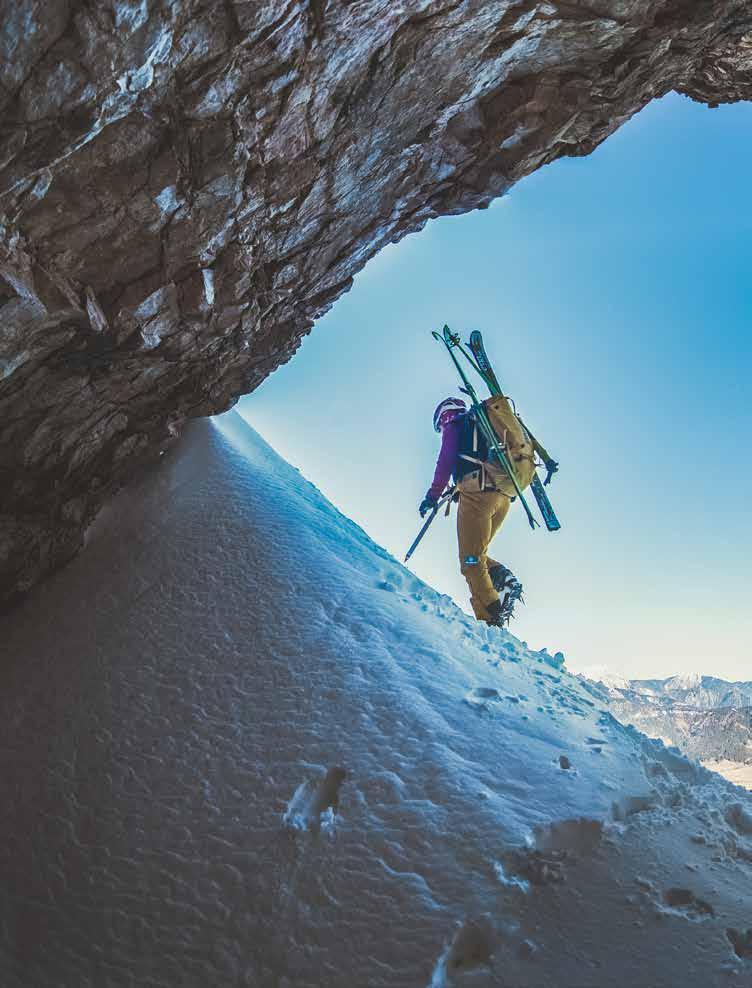


Skiers of all types, cross-country skiers, snowboarders, sledders and lovers of all other winter sports can find the perfect spot for their outdoor activities in sports centres where snow is assured even when nature is less generous with it. Slovenia’s special advantages are manageable distances and easy access to all major winter centres. Visit them also in spring, summer and autumn when they provide numerous possibilities for active green experiences. Smaller centres all over Slovenia also cater for beginners and families.
Planica Nordic Centre
Kranjska Gora
Pokljuka
Vojsko
Kanin –Sella Nevea
1.140 m – 2.400 m 30 km c70 ha
Vogel
Bohinjska dolina
Soriška planina
Jezersko 896 m – 1.086 m 15 km
Logarska dolina
Ribniško Pohorje
715 m – 1.525 m 4,5 km 6 km
Mariborsko Pohorje
325 m – 1.327 m 41,5 km 27 km c250 ha
Trije kralji
1.170 m – 1.344 m 3 km c 14 ha
Rogla 1.050 m – 1.517 m 13,5 km 25 km c 100 ha
Stari vrh
1.287 – 1.550 m 9 km 25 km c25 ha
Straža, Bled
508 m – 632 m 1 km c 6 ha
Velika planina
1.412 m – 1.666 m 3 km 2,7 km
Krvavec
1.480 m – 1.971 m 30 km c106 ha
Celjska koča
560 m – 834 m 1,2 km 2,5 km c 4 ha
Cerkno
800 m – 1.300 m 18 km 5 km c70 ha
Gače
700 m – 965 m 7 km 6,5 km c 45 ha
Irrespective of whether you choose a mountain tourist and sports centre or any other holiday destination, you can visit several ski resorts with a single skiing ticket called Ski Pass Slovenia. You can choose from individual or family passes that are valid between two and seven days.
Ski centres
Centres for cross-country skiing
Altitude
Length of ski slopes
Length of cross-country trails c Ski area
Night skiing
In addition to maintained slopes for Alpine skiing and suitable ski lifts and other devices, the major Slovenian mountain centres provide equipment hire, and have ski schools, catering and accommodation facilities. On rocky and little overgrown high mountain slopes such as Kanin and Vogel, the ski season can last until May. Other ski resorts, such as Kranjska Gora in the Julian Alps, Krvavec and Golte in the Kamnik-Savinja Alps, Rogla, the Maribor Pohorje Hills and Kope in the Pohorje Hills feature welcoming plateaus among forests. Ski resorts of the pre-Alpine hills such as Cerkno and Stari vrh are particularly attractive for families. Numerous smaller ski resorts are an excellent choice for beginners.

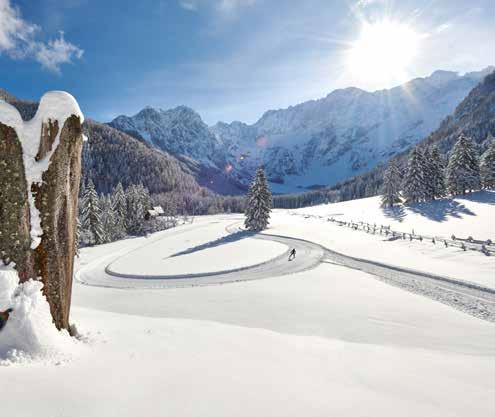
Ski touring enables genuine contact with wild winter nature on off-piste unmarked terrains. There are plenty of suitable terrains in Slovenia, but don't embark on this demanding sport alone! Even the most experienced should go on a ski tour in pairs, and with a mountain guide to areas they do not know. Depending on your preparedness and the weather, the guide will choose a suitable goal: descent from the top in the vicinity of mountain centres, ascent to the top and descent from it, which can be achieved in one day (for example, to the popular Komna) or a special experience such as the Juliana Ski Tour - a four-day trip across the Julian Alps with four different ski tours.
Cross-country skiing enthusiasts will find their perfect place in Planica Nordic Centre, where 800 metres of cross-country skiing track in an underground snow tunnel is also available in summer. More than 40 kilometres of tracks are arranged on natural snow in the nearby Kranjska Gora. The Pokljuka Plateau in Triglav National Park has a very good reputation among cross-country skiers. From more than 25 kilometres of tracks, there are also sections for competitive cross-country skiers. More than 65 kilometres of various tracks are arranged in the nearby Bohinj Valley when there’s snow. Top athletes and recreational sportspeople frequently visit the cross-country ski centre in Rogla, where there are 24 kilometres of tracks with various difficulty levels and a start-finish arena suitable for teaching beginners and practising. When there’s snow, cross-country skiing tracks can also be found in the vicinity of certain towns and attractive tourist destinations such as the Logar Valley, Jezersko and the Bloke Plateau, which is known as the cradle of the Slovenian skiing tradition.
 Jezersko
Jezersko

Venture on a snowshoe hike away from the maintained trails, along paths that you can’t even see under their thick layer of snow. Many mountain centres organise guided day and – particularly interesting – night hikes into pristine nature equipped with snowshoes and poles. In addition to sledging tracks, which can usually be found next to ski slopes, you can experience a true sledging adventure with a day or night descent of the longest sledging track in Slovenia from the Vogar mountain pasture in Bohinj (6 km), on the snowy road from Ljubelj (2.5 km) or Mt Mangart (3 km), on the first sledging track equipped with lights in Gozd Martuljek and on sledging slopes in Jezersko, the Selce Valley, the Velika planina Plateau and elsewhere.

In wintertime, seekers of exciting and new adventures in Slovenian sports centres get their thrills from snow rafting, airboarding, skijoring, skibiking, snow wakeboarding and many other thrilling sports.
Snowboarders are welcome at all Slovenian ski resorts. Special ski slopes are arranged for them and snowboarding outside those limits is not permitted. Those seeking special challenges and an ideal location for snowboarding should opt for the Vogel Snow Park with its multiple jumps (kickers) and other elements. The park is suitable for beginners and experienced or even professional boarders.
 Ljubelj
Rogla
Cerkno
Ljubelj
Rogla
Cerkno
Hiking and themed trails in the lowlands and the surrounding areas of towns are also accessible in winter. But observe all safety warnings when venturing into higher areas in low and high mountains because snow is a possibility from October to early summer. Don’t forget that most huts in the high mountains are closed in winter. Check the weather conditions and avalanche warnings. Learn how to walk with crampons and the correct use of an ice axe. Bring with you avalanche safety and rescue equipment. Rather than going by yourself, set out on a hike with an experienced guide as it will be easier to climb 2,000-metre peaks such as Mt Viševnik (2050 m) in the Julian Alps, Mt Stol (2236 m) in the Karavanke Alps or Mt Raduha (2062 m) in the KamnikSavinja Alps in winter. You can also experience a true winter fairy-tale in low mountains, including the Velika planina Plateau, the Škofja Loka Hills, the Polhov Gradec Hills, the Zasavje or the Pohorje Hills.
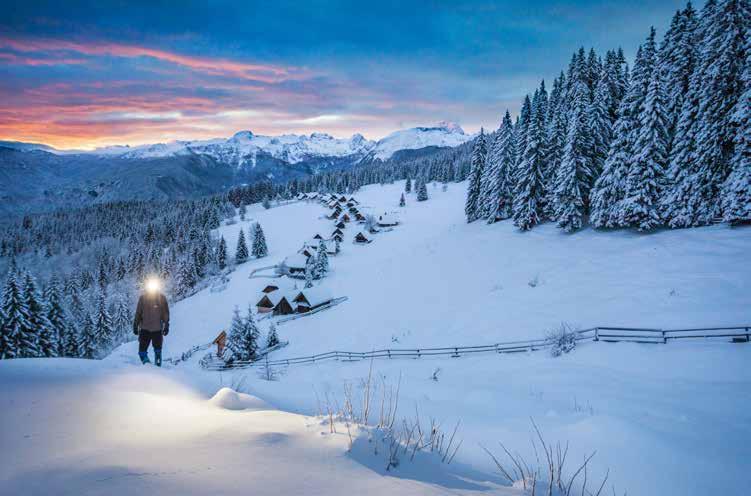

Slovenia is a country with an abundance of water. Numerous waterfalls that freeze in winter are a magnet for thrill seekers. Ice climbing should be done with full equipment and an instructor to begin with. In the Mlačca Gorge near Mojstrana, belay devices are provided on the frozen slope, making this site an excellent place for beginners. More experienced climbers can attempt the demanding Lucifer ice vertical in the nearby Gozd Martuljek, while the frozen waterfalls under Mt Prisank and in the Tamar Valley also present their challenges in the vicinity. The waterfalls of Log pod Mangartom are popular in the Soča River Valley, including those in the Trenta Valley, and when winter is particularly cold, climbers like to visit the Boka Waterfall, which has the largest water volume of all the falls in Slovenia. The opportunity to test your climbing skills on ice crystals also presents itself in the hidden gullies of the Logar Valley, which boasts more than 20 waterfalls. In addition to natural climbing sites, artificial walls can be found in Slovenia, too. A wall for rock climbing using ice climbing equipment (ice axe and crampons) for the so-called dry-tooling can be found in Domžale, which also hosts competitions of the European Ice Climbing Cup.
Planina Zajamniki mountain pasture
Since 1937 - Golf Royal Bled
It’s possible to enjoy this universal sport at 16 courses: seven 18-hole courses and nine 9-hole courses
Use the Alpe Adria Golf Card to discover courses on the sunny side of the Alps.

Find more information on the website. Set up your active holiday programme. Choose your accommodation and experience more.

Golf Kranjska Gora
9 , 1.748 m, par 32/64
Royal Bled
18 , 6.563 m, par 72 in
9 , 3.047 m, par 36/72
Golf Brdo
Golf Bovec
9 , 3.012 m, par 36/72
Diners Cubo
Golf Ljubljana
18 , 5.872 m, par 72
Mladinski golf center
Stanežiče
9 , 1.299 m, par 27/54
Golf Slovenske Konjice
9 , 2.448 m, par 36/72
9 , 887 m, par 28/56
Golf Arboretum
Ljubljana
18 , 5.015 m Par 71
Golf Trnovo
Ljubljana
9 , 2.470 m, par 34/68
Golf Lipica
9 , 6.225 m, par 36/73
Golf igrišče Livada, Moravske Toplice
18 , 6.236 m, par 72
Golf Radenci
9 , 1.669 m, par 31/62
Golf Ptuj
18 , 5.727 m, par 71
A Golf Olimje, Podčetrtek
9 , 2.081 m, par 31/62
Golf Grad Mokrice
18 , 5.785 m, par 71
Golf Grad Otočec
18 , 6.189 m, par 72
Due to their orderliness and settings in a diverse green landscape, Slovenian golf courses are some of the most scenic in Europe. Courses with 18 holes offer a sporting invitation to legendary Bled, the place with the oldest golf tradition in Slovenia and the largest course area; Ljubljana, Slovenia’s capital, where one of the most modern courses is open all year round; the nearby Arboretum Volčji Potok with a golf course situated next to a botanical garden; Otočec where the course lies next to a picturesque water castle; Mokrice with its course stretching below medieval castle walls only a stone’s throw away from Terme Čatež Spa; Moravske Toplice with its nearby Terme 3000 Spa and where the attractive course boasts a 600-metre long field; and Ptuj, the oldest Slovenia town, where water features present a special challenge.
In addition to the well-established courses with 18 holes, golfers can also find 9-hole courses and various driving ranges. Enjoy a round of golf when on holiday in the Soča River Valley or in Bovec, when visiting Lipica, the cradle of the Lipizzan horses in the Karst, the protocol estate of Brdo pri Kranju, the Zlati Grič Estate covered with vineyards in Slovenske Konjice or when staying in the health resorts of Radenci and Podčetrtek. Visit driving ranges for long and short games in Stanežiče or a public course in Trnovo, both in Ljubljana, where you can test your skills even if you’re a beginner in the company of an experienced golfer.

Golf has been played in Slovenia since 1937 and the best Slovenian courses have hosted numerous tournaments and European championships since then. In 2015, Slovenia was the Undiscovered Golf Destination of the Year according to IAGTO (International Association of Golf Tour Operators), and it recently hosted the International Golf Travel Market. Slovenia’s special advantage is easy access to mutually cooperative golf courses in the Alpe-Adria region. In addition to Slovenian courses, the annual golf card, i.e. the Alpe-Adria Golf Card, enables visits to the courses in neighbouring Austria and Italy.
 Lipica
Arboretum Volčji Potok
Lipica
Arboretum Volčji Potok

440 years of breeding the Lipizzan horses in Lipica – since 1580
More than 140 years of harness racing in Ljutomer
62 members of the Equestrian Federation of Slovenia (clubs, societies, breeders’ associations, tourist farms with equestrian activities)
30 equestrian competition clubs

Find more information on the website. Set up your active holiday programme. Choose your accommodation and experience more.


The diversity of green Slovenia can be explored by horseback riding on the tourist farms and ranches found in all Slovenian regions, at equestrian clubs offering riding schools in arenas or out in the field, when attending competitions and other equestrian events, in places with a unique equestrian heritage and on longer riding tours. Horsedrawn carriage rides are also available in many places, while children will be thrilled to meet the ponies.

Guided horseback riding tours are possible in many places in Slovenia. You can also go riding in landscape and regional parks, and Triglav National Park. Maintained horse-riding trails can be found in Bohinj, the Pokljuka Plateau, Idrija, the Pohorje Hills, the Kočevsko, Bela krajina and Posavje regions, and elsewhere. Nowadays, popular trails are even presented in digital form. For example, check out the digitalised trails of the Obsotelje and Kozjansko regions

When in Slovenia, horse lovers stampede to Lipica, which is the original stud farm for these white horses, established in 1580. These thoroughbred horses can be seen on meadows, in stables, at official training sessions and presentations of the classical riding school. You can choose from short and weekly dressage programmes, venture on trail riding or take a carriage ride.

Over 13,000 Karst caves
New discoveries: up to 100 caves a year
The oldest tourist cave in Europe: Vilenica , 1660
The largest and most visited cave in Europe with the greatest biodiversity in the world: Postojna Cave
Škocjan Caves: natural monument listed by UNESCO World Heritage
More than 40 caving societies

Dig into more information. Set up your active holiday programme. Choose your accommodation and experience more.

ߩ A special cave train will take you to the magnificent sculptures, stalactites, stalagmites, and halls of Postojna Cave, the most popular Karst cave in Europe. In the vivarium, you can admire the "human fish" (proteus) and interactively experience Karst phenomena at the Expo Cave Karst exhibition.
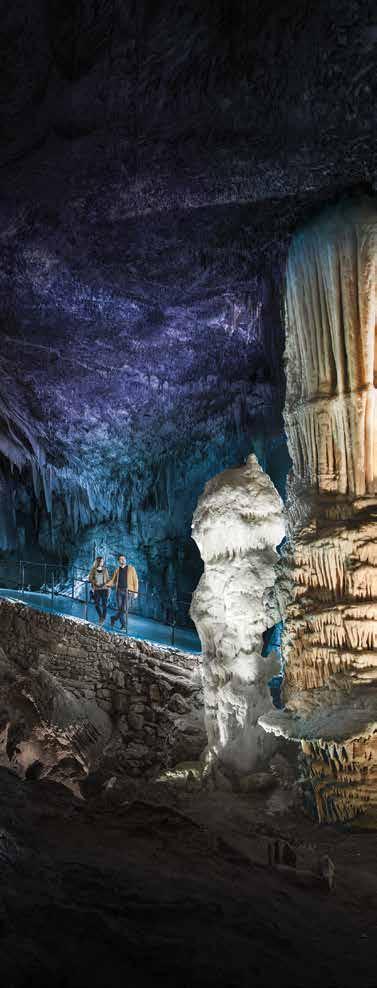

ߩ Predjama Castle, the largest cave castle in the world, hides behind its walls an impressive four-level underground cave, the second longest tourist cave in Slovenia.
ߩ One of the largest known underground river canyons in the world can be found in Škocjan Caves, inscribed on the UNESCO World Heritage list.
ߩ You’ll be taken by boat across emerald green lakes to the site where the remains of a cave bear were found in Križna Cave.
ߩ Planina Cave is the largest water cave in Slovenia. This cave boasts one of the largest confluences of underground rivers in Europe.
ߩ Different coloured underground halls can be admired in Vilenica Cave, the first tourist cave in Europe.
ߩ With tunnels on two levels, Dimnice Cave offers fascinating lessons in natural science.
ߩ In Divača Cave, you can find a speleothem cave called Zakladnica (treasure trove), which has white and red curtains and large crystals.
ߩ You can see the highest underground waterfall in Slovenia in Pekel Cave in the Savinja Valley.
ߩ In Snežna Cave, the highest situated tourist cave in Slovenia, it’s possible to walk around an ice hall that has an ice pillar even in summer.
ߩ Kostanjevica Cave near Kostanjevica na Krki reveals the fauna of the underground world as well as various speleothem forms.
ߩ Mayor’s Cave (also known as Tabor Cave) near Grosuplje has, among other features, an ice hall in which ice crystal stalagmites form in winter.
Postojna Cave
In addition to a train ride in the iconic Postojna Cave, it’s also possible to experience the excitement of the first cave explorers in Postojna Cave Park, an experience well worthy of the Slovenia Unique Experience label. Equipped with a rope, a helmet and a helmet lamp, you will venture on a hike with an experienced guide through three caves (Postojna, Black and Pivka caves) in the footsteps of Luka Čeč or explore other non-tourist tunnels.


In addition to numerous Karst caves, Slovenia also harbours the remains of former mines. In the subterranean world of Mt Peca in the Koroška region, a part of the Karavanke UNESCO Global Geopark, you can treat yourself to a special five-star Slovenia Unique Experience label adventure some 700 metres below the surface. Paddle through the flooded tunnels of the former lead and zinc mine in a kayak, or cycle along the 5-kilometre trail winding through the mine tunnels.
Peca, Koroška In the Footsteps of Luka Čeč
Seeing Slovenia from a bird’s eye view allows you to experience its beauty in a new way. Various views of mountain peaks, valleys and plains reveal the diversity of this green country.
The knowledge needed for independent flying, the power and skills required to move among the treetops, the pulse that accelerates when descending to the depths far below, the trust in the pilot taking you closer to the sun – all of these not only enrich our memories, but also our appetite for life. Enjoy the sports challenges provided by the Slovenian sky, indulge in adrenaline adventures high above the ground.

78
82

More than a dozen sports airports
Over 40 take-off sites for paragliding and hang gliding
Tandem paragliding from intriguing locations – as well as from ski centres
Excellent wind conditions: more than 300 flying days i n the Goriško and Vipavsko regions

Find more information on the website. Set up your active holiday programme. Choose your accommodation and experience more.

There are several sport airports for motor gliders and sailplanes. Many organise panoramic flights and air trips that provide a spectacular vantage point for the beautiful sights of the green country. Mt Triglav, the highest Slovenian mountain, the famous Alpine lakes, the Adriatic Sea, Ljubljana and other towns can be seen from a bird’s eye view. It’s also possible to lease or hire a plane at certain airports. Several flying schools and clubs train pilots of motor, ultralight and paragliding aircraft and paragliders, too.

Sports airport: 1. Lesce, 2. Bovec, 3. Ajdovščina, 4. Divača, 5. Postojna, 6. Šoštanj, 7. Slovenj Gradec, 8. Celje, 9. Slovenske Konjice, 10. Skoke, Maribor, 11. Moškanjci, Ptuj, 12. Murska Sobota, 13. Novo mesto, 14. Prilozje, Metlika International airports: 15. Brnik, Ljubljana, 16. Portorož, 17. Maribor
In Slovenia, you’ll find more than 40 registered take-off sites for paragliders and hang gliders. Among the most attractive are those in the Soča River Valley, in the area of Bohinj, and in the Goriško and Vipavsko regions where the flying season lasts 300 days.
The Slovenian ski slopes, such as Krvavec, Vogel, Cerkno, the Soriška Planina Plateau, Golte and the Pohorje Hills are also popular take-off sites. A suitable licence is needed for independent paragliding. Slovenian paragliders and hang gliders who excel at international competitions will make sure that your flying experience in tandem is unforgettable. Choose a licensed provider with experienced instructors.

Sunrises and sunsets look different if seen from a balloon crossing the Ljubljana Marshes, Lake Bled, the Pannonian Plan and other scenic sights that attract balloonists from all over the world. Balloon clubs with suitable certificates for conducting hot air balloon transport will lift you into the sky and safely bring you back down to earth at several locations in the country.
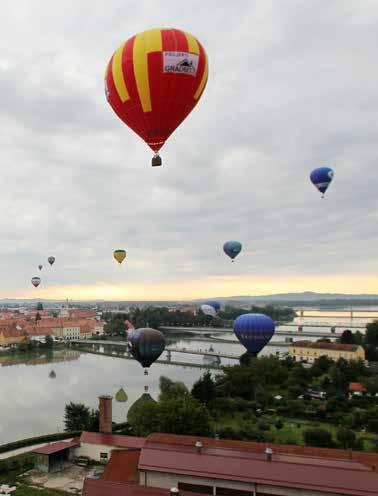

Lesce-Bled Airport was the site of the first world parachuting championship in 1951. Trained and licensed parachutists can find great opportunities at sports airports where experienced instructors oversee adrenaline-pumping but safe jumps with a tandem parachute from an aircraft or a helicopter at an altitude of 3-, 4- or 6,000 metres. And they also photograph your adventure in the sky.

The largest zipline park in Europe: the Učja Canyon
The steepest zipline in the world: Planica, descent from a ski jumping hill
The longest continuous adrenaline zipline in Slovenia: Olimpline, Črna na Koroškem
More than 20 adventure parks for all generations.
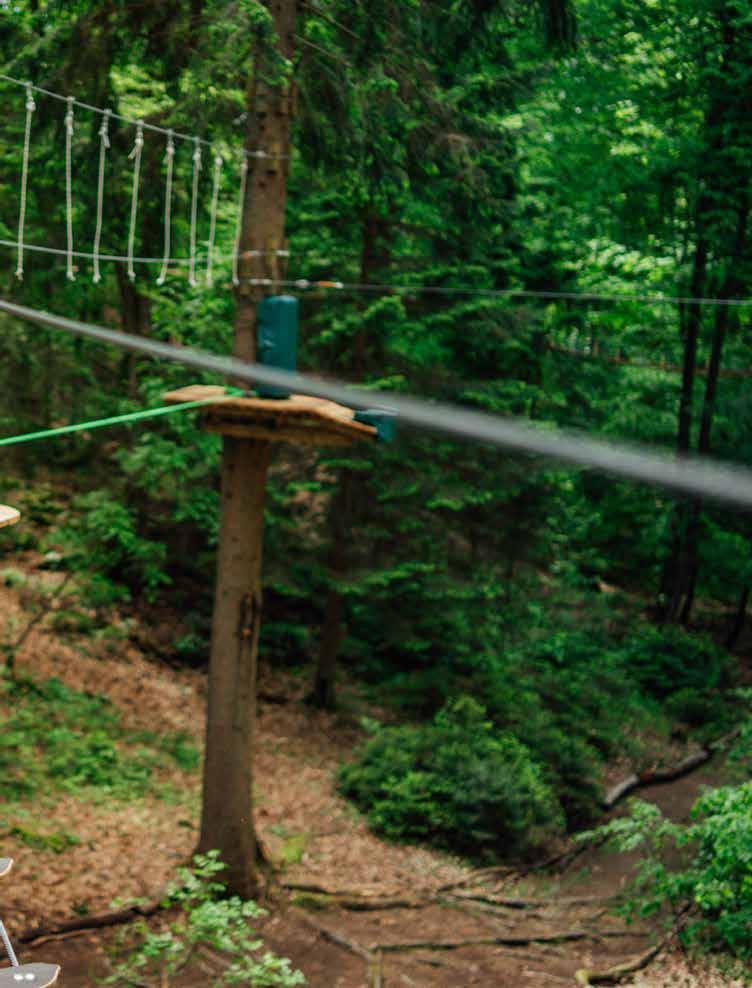
Find more information on the website. Set up your active holiday programme. Choose your accommodation and experience more.


Test your courage in Slovenian parks by sliding down a zipline for an unforgettable adventure:
ߩ Olimpline, the longest continuous adrenaline zipline in Slovenia, can be found in Črna na Koroškem where you will descend down a 1,260-metre long zipline. The elevation difference between the starting and finishing points is 200 metres and the speed of the descent reaches up to 120 km/h.
ߩ The steepest zipline descent in the world is in Planica, the venue of breathtaking ski jumps on the famous ski jumping hill. Speeds of up to 85 km/h can be reached on the 566-metre descent.
ߩ Europe’s largest zipline park is situated in the Soča River Valley. The Učja Canyon with ten ziplines, 4 kilometres of steel cables stretching 200 metres above the ground and providing speeds of up to 60 km/h will leave you totally buzzed.
ߩ You can also fly above the Soča River on a zipline in Kanin. It’s possible to descend above the Krnica Valley in winter, too.
ߩ In the vicinity of Bled, seven ziplines with a total length of 4 kilometres invite you to fly over the Sava Dolinka River. On the descent down the Dolinka zipline, you cross the valley that intertwines forests and wetlands and is part of the Natura 2000 network of protected areas seven times.
ߩ Five ziplines also stretch above luscious forests in Bohinj where you can top off the experience with a 10-metre freefall.
ߩ At Sunny Paradise Estate in Maribor, a zipline descent will connect you with the life of bees. A descent, 35 metres above the ground and known as the Bee Flight, runs in two directions and meetings in mid-air further add to the excitement.
ߩ In addition to the 200-metre descent at Golte in the KamnikSavinja Alps, you can also test your skills on the artificial climbing wall where a guide will show you the ropes.
Zip line Planica SolkanFor many years now, bungee jumping has been one of the most popular adrenaline challenges. You can try it in the Soča River Valley, which offers a 55-metre jump amidst extraordinary surroundings. Towards the Soča River, you will jump from a bridge in Solkan near Nova Gorica.

A powerful air current will make you float in Planica Nordic Centre and Aerodium in Logatec. Wind tunnels that are used for parachuting practice are a fun adrenaline adventure even for those with no flying experience.



ߩ There are adventure parks in Bovec, Kobarid, Log pod Mangartom and the Srnica Gorge in the Soča River Valley, which is considered to be THE adrenaline valley. Bovec Adventure Park features challenges for children, adults and the particularly daring. To get their pulse pounding, visitors can enjoy activities in Kamp Koren Adventure Park in Kobarid, the Centre of Adventures under Mangart and the Park of Active Adventures in the Srnica Gorge. The Soča Fun Park in Solkan near Nova Gorica is also enticing; in addition to four polygons and the crossing of the Soča River by raft, a zipline across the Soča poses a true test of courage.
ߩ In the Bohinj Adrenaline Park, you can climb 14 metres above ground and try a giant swing.
ߩ The Bled Adrenaline Park combines adventures for the entire family with various outdoor activities, including summer tobogganing.
ߩ The Postojna Adrenaline Park has as many as 78 different fun obstacles featuring bridges, ladders, nets, ropes and wires for forest adventures.
ߩ The Summer Park 7 Activities at Krvavec boasts a trampoline, a climbing tower, a slackline, frisbee golf, archery and downhill with a tube.
ߩ Near the Geometric Centre of Slovenia at Vače, there’s the Geoss Adrenaline Park, which among other attractions provides a giant zipline 25 metres above the ground, seven climbing courses and 97 climbing elements. A particular feature of the park is a forest exercise space for children (Geoss) and the option of spending a night in the treetops.
ߩ The Funpark Menina in the Savinja Valley has two courses (for children and adults) with various stations and a zipline over the lake and across the entire camp.
ߩ The Celjska Koča Adventure Park above Celje has 35 different elements in treetops and three polygons of various difficulty levels. There are also two ziplines with a total length of 829 metres.
ߩ The Otočec Adventure Park features four adventure tracks with 46 adrenalin-pumping climbing adventures; two tracks are suitable for children aged 5 and above.
ߩ The Peter Klepec Adrenaline Park in Osilnica invites you to experience the Flying Peter zipline, a giant swing, an abseiling wall and a leap into the void.
ߩ The Bukovniško Jezero Adventure Park near Murska Sobota has 8-metre high elements and the Stork Flight with a range of 27 metres.
ߩ Children as young as three can climb into the treetops in Maribor’s Betnava Adventure Park.
ߩ The Vurberk Adventure Park is situated in the vicinity of Duplek near Maribor, next to the castle of the same name.
ߩ The Stari Vrh Family Park in the Škofja Loka Hills has six adrenaline courses, a climbing wall and a more than 400-metre zipline.
ߩ The adrenaline park in the Cukarca Adventure Park near Šentvid pri Stični offers as many as 50 different exercises at four different heights on 500-metre-long trails. Here, in addition to adults, children from the age of 4 can also practice their skills.

Slovenia is one of the richest European countries in water resources. In every region, there are unique experiences on, in and by the water.
Pannonian Slovenia is famous for its springs of healthy thermal and mineral waters, but also for calmer rivers and lakes. Central Slovenia between the Ljubljanica, the river flowing through Slovenia’s capital, and the Kolpa, the warmest Slovenian river, provides an abundance of possibilities for water experiences.
Alpine Slovenia excites with springs, streams, waterfalls and whitewater rivers that also attract adrenaline lovers. Mediterranean & Karst Slovenia delight with the Adriatic Sea and surprise with mysterious waters which fill up Slovenia’s largest lake in one season and then disappear underground in another. Among such diverse waters, even at first glance similar forms of fluid movement are in fact surprisingly different each time.


One of the most water-rich European countries:
More than 27,000 kilometres of watercourses
The emerald Soča River – the adrenaline valley Slovenia’s longest river, the Sava and its two springs Slovenia’s warmest river, the Kolpa with its natural bathing areas
More than 300 waterfalls
As many as 93 freshwater fish species

Find more information on the website. Set up your active holiday programme. Choose your accommodation and experience more.

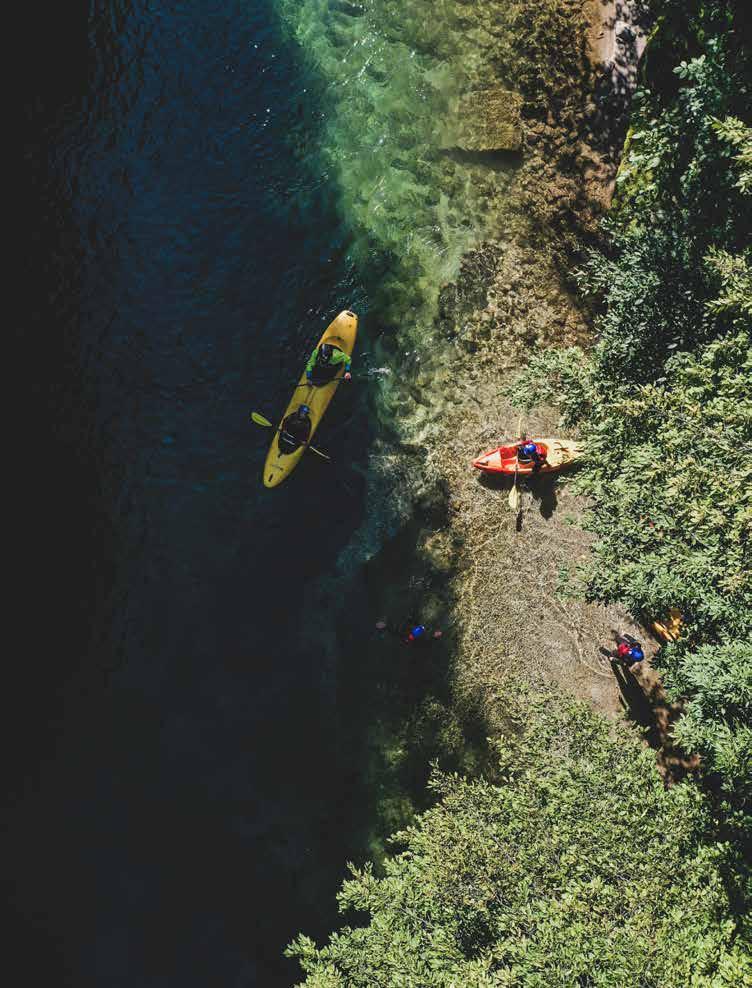
The valley of the emerald Soča River is a world-renowned paradise for adrenaline water experiences. Many exciting adventures can also be found on the Sava Dolinka, the Sava Bohinjka, the Savinja and other beautiful rivers and their tributaries. Rafting, kayaking, canoeing, hydrospeeding, bellyaking and tubing can be enjoyed on Slovenian rivers. Canyoning, which combines climbing, swimming, jumping in pools, hiking and climbing natural slides and waterfalls with ropes, is an unforgettable experience. The gorges near Bovec, Kobarid, Bled and those in the Upper Savinja Valley are particularly known for this type of activity. Stay safe when engaging in adrenaline-fuelled activities. Use suitable equipment and hire guides.

There are many Slovenian rivers where visitors can find pleasant refreshment and relaxation. Bathing is permitted in bathing areas where the water quality is regularly tested. You can find such areas on the Soča, the Nadiža, the Idrijca, the Krka and the Kolpa, which is considered to be the warmest river in Slovenia. It has a long embankment, a riviera with numerous bathing areas. The camps along the river provide numerous activities and there’s a large sports centre for water activities.

You can also go rafting on calmer rivers such as the Kolpa, the Krka, the Sava, the Drava and the Mura in eastern Slovenia. There are also opportunities for boating, rowing and SUPing. The latter is an option on the Ljubljanica in Ljubljana, the Drava in Maribor, the Krka in scenic Novo mesto and Kostanjevica na Krki and many other places.

Sport fishing has a rich tradition in Slovenia and fly fishing is its finest and particularly revered form. In a country with over 27,000 kilometres of watercourses in a territory of 20,273 km2 and around 1,300 lakes of more than one hectare, it’s possible to fish and fly fish among the Alpine peaks or while surrounded by Karst phenomena, close to the sea or the vine-growing hills, in the vicinity of towns or hospitable villages, but always with a feeling that you are truly far away from the everyday rhythm of the modern world. Of the total of 12,000 hectares of water surfaces, one third are salmonid waters and the remaining are mixed and cyprinid waters.
According to folk tradition, Slovenian rivers are sisters that compete in their search for the route to the sea. The Soča and its tributaries flow from the Alps to the Adriatic Sea, and the Sava with its tributaries flow to the Danube Basin and on to the Black Sea. The waters of the Adriatic Sea basin are the home of indigenous species, among which the marble (Soča) trout (Salmo marmoratus), the largest representative of the salmonid species, is particularly of interest. The most typical representative of the Danube River basin is the huchen (Hucho hucho).
No fewer than 93 fish species live in Slovenian waters. 33 species are protected. Approximately 25 fish species are suitable for sports fishing. They are being caught in 12 fishing areas of Slovenia.

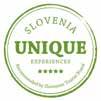
Fish & Fly Trio is an attractive new project that challenges fly fishing enthusiasts to catch three indigenous fish species - grayling on the Kolpa River, river trout on the Krka River and marble trout on the Soča River. Fishermen are accompanied on the three-day experience by an experienced fishing guide, and guests are transported from one location to another by helicopter. Along with experiencing each river, fishermen can also taste local delicacies.

The fly fishing tradition in Slovenia is over 100 years old, and its fly fishing school, which uses cleverly designed artificial lures made by local fishermen, is highly respected worldwide. Fly fishing is the only permitted means of fishing in certain Slovenian fishing districts. The most scenic fly fishing district is certainly the Soča River with its tributaries such as the Idrijca River. Fishermen attracted to this type of basic hunting are also drawn to the Sava Bohinjka, the Sava Dolinka, the Krka, the Unica, the Reka, the Radovna and numerous other rivers and certain lakes.
Keen fly fishing enthusiasts return to Slovenia for huchen, the king of Slovenian waters. The most suitable rivers for catching huchen are medium-sized rivers like the Sora, the Savinja, the Kolpa and the Sava Bohinjka. Slovenian rivers are an excellent choice for fishermen going after cyprinids (chub, barbel, cactus roach, carp) and pike that are caught by using streamer flies.
The largest carp caught in Slovenia weighed more than 34 kilograms. It’s possible to catch large fish in Slovenian lakes and rivers almost all year long, the exceptions being during spawning season and when the surface is frozen. In addition to Lake Šmartinsko near Celje, where the record-sized carp was caught, other notable fishing districts include Lake Vogršček near Nova Gorica, Lake Slivnica near Šentjur, Lake Gajševci near Ljutomer and several other lakes, ponds and gravel-pit ponds. The best rivers for catching carp are the Ljubljanica, the Krka, the Pivka, the Vipava and the Sava.

More than 1,300 lakes
A legendary lake with an island: Lake Bled – the icon of Slovenian tourism
The largest Slovenian permanent lake: Lake Bohinj in Triglav National Park
The largest intermittent lake in Europe: Lake Cerknica
The lake with the longest shoreline: Lake Šmartinsko near Celje

Find more information on the website. Set up your active holiday programme. Choose your accommodation and experience more.


Lake Bled boasts a superb Castle Bathing Area and four bathing sites with many opportunities for numerous activities. The Šobec Pond natural bathing site is in the vicinity of Bled and features a water park for children. Bathing areas at Lake Bohinj are arranged in the Fužina Bay and Ukanc.
In addition to bathing areas checked regularly by competent national institutions, you can also find other natural bathing sites. The Radlje ob Dravi Water Park in the Koroška region features a natural biological pool. The beach by Lake Velenje is one of the most well-maintained lake areas for recreation. You may also be tempted to take a dip in Lake Jasna near Kranjska Gora, Lake Bloke surrounded by the vast forests of the Bloke Plateau, Lake Podpeč near Ljubljana and many others.
The lakes, which attract swimmers with their beaches and waters, also frequently feature water sports centres that lease a variety of sports equipment for relaxation and recreation. You can SUP, surf, row, play beach volleyball, football and basketball or engage in golf and other sports. Walking, hiking and cycling trails are often found in the vicinity of lakes. There are also guided programmes for different activities and extraordinary experiences on or by the water. Opportunities for pleasant recreation can be found at Lake Cerknica (when it is full), Lake Zbilje with its popular boathouse near Medvode, Lake Šmartinsko near Celje, where you can find a pontoon bridge across the water surface, Lake Sobota with the Expano Pavilion in Murska Sobota, on Lake Ptuj, which is famous for being a habitat for various birds, a lake next to Most na Soči and many other lakes.


Wakeboarding and water skiing, in which cables are used for additional adrenaline-pumping speed, can be enjoyed at the largest sports centre for wakeboarding and water skiing, Wake Park Dooplek near Maribor, where the largest trampoline in Slovenia can also be found in the adjacent water park. The Green Lake Sports and Recreation Centre offers extra water experiences, such as wakeboarding on a 420-metre-long cable and a number of other sports and fun experiences. Fun-packed adventures also await you at Lake Šmartinsko recreational centre near Celje where, in addition to the wakeboard cable, an array of other water activities can be experienced. The majority of parks also cater for beginners.
Wakepark Dooplek, Duplek

As many as 21 bathing areas on 46.6 km of coast
Average summer sea temperature: 24 °C
Average depth of the Slovenian section of the Adriatic Sea: 17 metres
Deepest point: Underwater Triglav: 39.6 metre; marked by a 2,500-kilogram pyramid
Strunjan Landscape Park with Moon Bay and 80-metre flysch cliffs
Sečovlje Salina Nature Park with traditional salt harvesting
Debeli Rtič Landscape Park
Town experiences: Koper, Izola, Portorož, Piran, Ankaran
Sub-Mediterranean climate with hot summers and mild winters: suitable for outdoor activities all year long
Find more information on the website. Set up your active holiday programme. Choose your accommodation and experience more.

The central sandy beach in Portorož, bathing sites in the Fiesa Bay near Piran, the Simonov Zaliv Bay and at the lighthouse in Izola, Koper City Beach and the Žusterna bathing site are great for swimming and bathing in the clean and warm Adriatic Sea. Experience the authentic touch of nature in Moon Bay in Strunjan Landscape Park and at Debeli rtič near Ankaran. There are as many as 21 outdoor bathing areas along the coast whose quality of water is controlled. It’s also possible to bathe in seawater in the swimming pools of top hotels on the Slovenian coast.

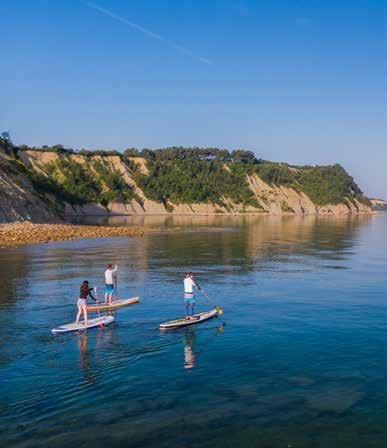
Beautiful sights on the Slovenian coast can be enjoyed while SUPing. While paddling a SUP and gliding over the sea, you can enjoy the views of Moon Bay in Strunjan and Debeli rtič or simply admire unforgettable sunsets. Attend a SUP course or a guided trip. A SUP board can be leased and delivered to the desired location. Trips with kayaks also provide magnificent views of the coast.
Kitesurfing, windsurfing, water skiing – indulge in these water activities at the Seča Cape near Portorož and on the Lighthouse beach at Petelin Cape near Izola. Lease the equipment in Portorož, sign up for a kitesurfing or windsurfing course or attend hydrofoil racing practice sessions.
Strunjan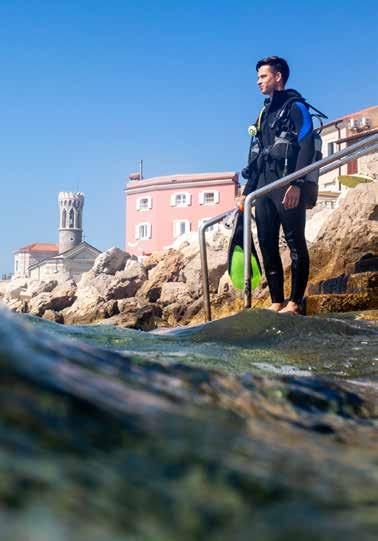
Fishing from a boat, you can catch garfish, gilt-head sea bream, or the common pandora, and if you venture to the open sea you can even try to land the Atlantic mackerel and the common dolphinfish. During the colder weather, fishermen on the shore can successfully catch squid, cuttlefish and whiting, and also sea bass at the mouths of rivers and canals. A daily or weekly permit is needed for recreational boat fishing, but a permit is not required for recreational shore fishing.
Sailing has a long tradition in Slovenia. A well-developed infrastructure enables the organisation of regattas, the dissemination of knowledge via sailing schools, the lease of equipment and even sailing trips. Favourable winds blow along the Slovenian coast and the best sailing conditions are from April to the end of June and between September and mid-November. The largest Slovenian regatta is organised annually in Portorož. More than 500 sailors compete at the Easter Regatta for the Optimist Class.
After a diving course on the Slovenian coast, discover the underwater mysteries along the attractive Madona Cape at the end of Piran's Punta, the Fiesa Reef and several other locations. There are relics from the Second World War in the Slovenian sea such as a sunken saboteur boat and the wreckage of a barge and hydroplane. A special diving site is the Underwater Triglav, the deepest point in the Slovenian sea (39.6 metres), which you can visit using specialised diving equipment.

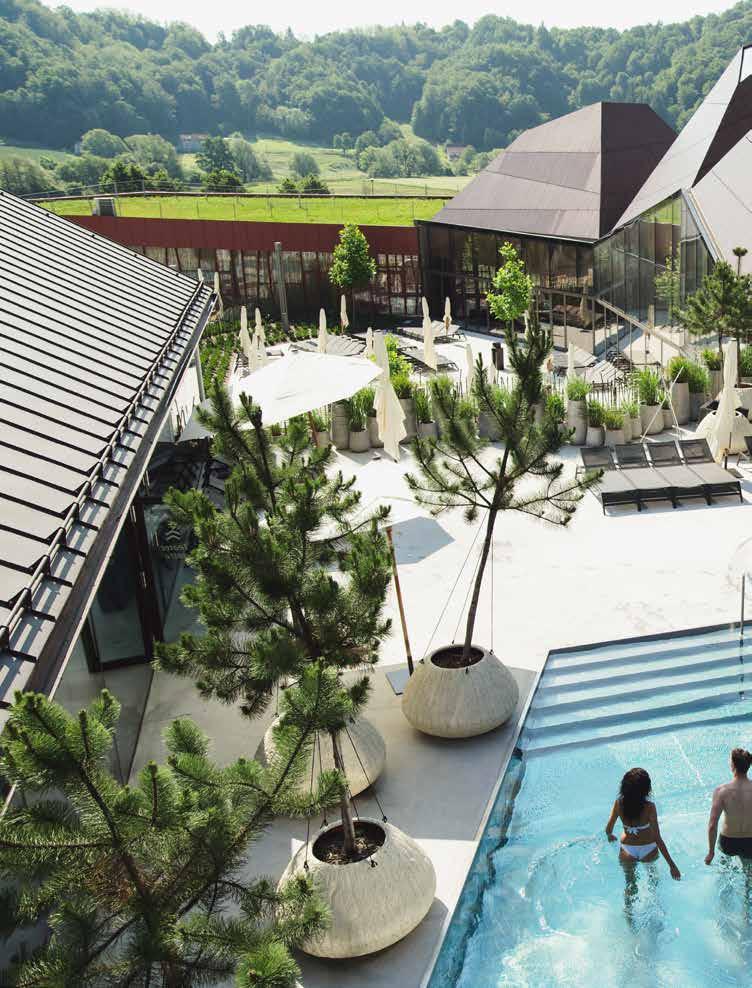
Those who enjoy the water know that Slovenian natural health resorts and spa centres are an excellent choice for relaxing holiday experiences, as well as water recreation. Their outdoor and indoor swimming pools enable recreational swimming in all seasons. Some even have Olympic-size swimming pools suitable for more demanding swimming and competitive challenges.
Most Slovenian health resorts and spa centres have water parks providing fun and water attractions and a rich offer of various recreational options in their surrounding areas. Slovenian health resorts that rank at the top of the Slovenian tourist offer are the perfect starting point for many forms of outdoor recreation and always the best choice for recuperating after various physical and mental constraints or for exercising and preparing for major recreational and sports challenges.


When planning active experiences, make sure you obtain suitable information before setting out. Check information at the national web portal www.slovenia.info, specialised web portal for outdoor activities www.slovenia-outdoor.com, and on destination web portals. For more specific information, visit the tourist information centres that you can find all over Slovenia. Regarding local conditions, consult with the experts in the reception offices of accommodation facilities and directly with tourist experience providers. Enjoy your activities safely and responsibly.
1 Bled www.bled.si 2 Kranjska Gora www.kranjska-gora.si
3 Dolina Soče www.soca-valley.com 4 Bohinj www.bohinj.si
5 Cerkno www.visitcerkno.si
6 Radovljica www.radolca.si
7 Kranj www.visitkranj.com
8 Marbor – Pohorje www.visitmaribor.si
9 Rogla – Pohorje www.rogla-pohorje.si
10 Zgornja Savinjska dolina www.visitsavinjska.com
11 Koroška www.koroska.si
12 Portorož – Piran www.portoroz.si
Izola www.visitizola.com
Koper www.koper.si
Ankaran www.visitankaran.si 16 Kras www.zelenikras.si www.visitkras.info 17 Nova Gorica in Vipavska dolina www.novagorica-turizem.com www.vipavskadolina.si
MEDITERRANEAN & KARST SLOVENIA
All types of outstanding accommodation facilities located in the direct vicinity of outdoor recreational venues can be found in green, active and healthy Slovenia. Choose a hiking or cycling accommodation facility, a camp or glamping site in nature, a room or an apartment in a family or boutique hotel, an overnight stay in a mountain hut, or a break at a tourist farm. Facilities equipped with the Slovenia Green label deserve your special attention because they meet the demanding international standards of sustainable development.
Choose your accommodation: ௴ www.slovenia.info/accommodation ௴ www.slovenia-outdoor.com
Whatever activity you choose, be mindful of your fitness level. Choose activities that suit your knowledge, experience and physical abilities. Before venturing outdoors, check the weather and other conditions.
The publication is of an informative nature only. When outdoors, you are solely responsible for your own safety. Let’s behave responsibly towards ourselves and others.
18 Brda www.brda.si
THERMAL
19 Ptuj www.visitptuj.eu
20 Pomurje www.visitpomurje.eu
21 Velenje in Topolšica www.visitsaleska.si 22 Dobrna www.dobrna.si 23 Celje www.visitcelje.eu
24 Laško www.lasko.info
25 Podčetrtek www.visitpodcetrtek.com 26 Rogaška Slatina www.visit-rogaska-slatina.si
27 Posavje in Terme Čatež www.posavje.com
28 Dolenjska www.visitdolenjska.eu
Ljubljana www.visitljubljana.com
30 Kamnik www.visitkamnik.com
31 Cerklje na Gorenjskem www.visitcerklje.si
Bela krajina www.belakrajina.si 33 Kočevsko www.kocevsko.com
Škofja Loka www.visitskofjaloka.si
www.visit-idrija.si

With a good guide, appealing accommodation specialised for hikers and cyclists and an array of great experiences to choose from, your active holiday in a scenic location gets even better! Find the best accommodation and active experience package for you at www.slovenia-outdoor.si, where you can choose among superb offers from more than 50 members of Slovenia Outdoor – an association of specialised accommodation facilities for cyclists and hikers, incoming sports agencies, the Association of Slovenian Ski Lift Operators and destination organisations. We connect selected destinations, products, experts in hiking, cycling, skiing and other winter activities, water and air sports and other outdoor activities around Slovenia.
#sloveniaoutdoor
#ifeelsLOVEnia
#myway www.slovenia-outdoor.com
SLOVENIAN TOURIST BOARD
Dimičeva ulica 13, SI - 1000 Ljubljana t +386 1 589 85 50 info@slovenia.info www.slovenia.info
Published by: Slovenian Tourist Board • Editor: Miha Renko • Design and Layout: Terminal Studio d.o.o., kf - grafično oblikovanje • Text: Ines Drame and the Slovenian Tourist Board • Translation: PSD d.o.o., Secretariat-General of the Republic of Slovenia, Translation and Interpretation Division • Cover
Photo: Mangart, Arhives of the Slovenian Tourist Board: Ciril Jazbec - CJ STUDIO d.o.o. • Photos: Archives of the Slovenian Tourist Board: CJ STUDIO d.o.o. - Ciril Jazbec, Iztok Medja, Aleš Fevžer, Jošt Gantar, Tomo Jeseničnik, Jaka Ivančič, Michael Matti, Archives of RRA Zeleni Kras d.o.o., Andrej Tarfila, Ben Prescott, Christine Sonvilla, Unitur d.o.o. – Iztok Medja, Anže Čokl, Andrew Lloyd, Luka Ploj, Primož Šenk, Andrej Virc, Matic Klanšek Velej – Sportida d.o.o., Dean Dubokovič, Matej Vranič, Alex Strohl, Mankica Kranjec – Nea Culpa d.o.o., Aleš Zdešar, Luka Karlin – Virc Studio, Nebojša Tejić - STA, Anže Malovrh – STA, Robi Poredoš – STA, Daniel Novakovič – STA, Stanko Gruden – STA, Jure Makovec – STA, Aleš Fevžer – Olimpijski komite Slovenije, Vid Ponikvar – Sportida d.o.o., Archives Postojnska jama d.d., Archives Golf Arboretum; Archives of Zavod za turizem Maribor: Sam Strauss Fotografie, Sportida d.o.o.; Archives of TIC Moravske Toplice: Jure Banfi; Archives of Turizem Kranjska Gora: Primož Pičulin; Archives of Postojnska jama d.d.; Archives of Julijske Alpe; Archives of Ski Association of Slovenia; Archives of Fundacija Poti miru v Posočju: Jure Batagelj; Archives of Skydive Bovec; Archives of Pustolovski park Bled: Peter Koren; Archives of TOP GO d.o.o.; Archives of Nordijski center Planica; Archives of EXPANO RCMS: Jan Vitez; Archives of Terme Krka; iStock: Simon Škafar, Žiga Plahutar • Map: Kartografija d.o.o. • Print: Rolgraf d.o.o. • Impression: 5.000 • 3rd Edition • February 2023